Sony Group SVF13NA1EL Personal Computer User Manual User Guide
Sony Corporation Personal Computer User Guide
User Manual

Personal Computer
VAIO Fit 13A Model: SVF13NA1EL
How to Use
Windows 8: The Basics
User account
Switching from a Local Account to a Microsoft Account
About User Account Types
Power
Controlling the Power State of Your VAIO Computer (Sleep Mode/Shutdown)
Restarting Your VAIO Computer
Entering Sleep Mode, Shutting Down, or Restarting
Using Sleep Mode
Display
About the Start Screen and Menu
Opening the Desktop
Internet
Installing Apps from Windows Store
Password
Switching from a Local Account to a Microsoft Account
About User Account Types
Apps
Searching/Starting Apps, Settings, or Files
Switching Apps
Viewing Running Apps
Installing Apps from Windows Store
Opening the App Menu
Closing Apps
Switching User Accounts
Windows
Opening Windows Help and Support
Menu
About the Start Screen and Menu
Opening Control Panel
Opening the Desktop
Opening the Charms

Windows 8
Controlling the Power State of Your VAIO Computer (Sleep Mode/Shutdown)
Restarting Your VAIO Computer
Using Sleep Mode
Store
Installing Apps from Windows Store
Switching User Accounts
Help and Support
Opening Windows Help and Support
Parts Description
VAIO computer
Parts and Controls on the Back
Parts and Controls on the Bottom
Parts and Controls on the Sides
Parts and Controls on the Front
Setup
VAIO computer
About the LCD Screen Rotation
Using Your VAIO Computer in Viewer Mode
Checking Supplied Items
Using Your VAIO Computer in Tablet Mode
Setting Up an Appropriate Work Environment
Power
Connecting a Power Source
Charging the Battery Pack
Turning On Your VAIO Computer
Controlling the Power State of Your VAIO Computer (Sleep Mode/Shutdown)
Battery
Charging the Battery Pack
Notes on Using the Battery Pack
Display
About the LCD Screen Rotation
Using Your VAIO Computer in Viewer Mode
Using Your VAIO Computer in Tablet Mode
Supplied items
Checking Supplied Items
Touch panel

Using Your VAIO Computer in Tablet Mode
Windows 8
Controlling the Power State of Your VAIO Computer (Sleep Mode/Shutdown)
Network / Internet
Internet
Using the Antivirus App for Your VAIO Computer
Connecting to the Internet with a Wired Connection (LAN port equipped models)
About the Internet Connection Services
About the Network (LAN)
Disabling the Wi-Fi(R) (Wireless LAN) Function
Notes on Using the Wi-Fi(R) (Wireless LAN) Function
Stopping Wi-Fi(R) (Wireless LAN) Communications
About the Wi-Fi(R) (Wireless LAN) Standards
Installing Apps from Windows Store
Starting Wi-Fi(R) (Wireless LAN) Communications
About a Security Key for Wi-Fi(R) (Wireless LAN)
LAN
Connecting to the Internet with a Wired Connection (LAN port equipped models)
About the Internet Connection Services
About the Network (LAN)
About the Wi-Fi(R) (Wireless LAN) Standards
About a Security Key for Wi-Fi(R) (Wireless LAN)
Wi-Fi
About the Internet Connection Services
Disabling the Wi-Fi(R) (Wireless LAN) Function
Notes on Using the Wi-Fi(R) (Wireless LAN) Function
Stopping Wi-Fi(R) (Wireless LAN) Communications
About the Wi-Fi(R) (Wireless LAN) Standards
Starting Wi-Fi(R) (Wireless LAN) Communications
About a Security Key for Wi-Fi(R) (Wireless LAN)
Apps
Installing Apps from Windows Store
Store
Installing Apps from Windows Store
Connections
VAIO computer
Using the LAN Port (LAN port equipped models)
Power

Connecting a Power Source
Display
Changing the Resolution (Size) of the Screen Image on an HDMI-Connected Device
Notes on the LCD screen
Using the Multiple Monitors Function
Selecting Display Modes
Connecting a TV with an HDMI Input Port
HDMI
Changing the Resolution (Size) of the Screen Image on an HDMI-Connected Device
Connecting a TV with an HDMI Input Port
Peripheral device
Connecting a High-Quality Digital Sound Output Device between Your VAIO Computer and a TV
Changing the Sound Output Device
Notes on the LCD screen
Using the Multiple Monitors Function
Selecting Display Modes
Connecting a TV with an HDMI Input Port
CD/DVD/BD
Connecting an External Drive
Audio
Connecting External Speakers/Headphones/Headset
Connecting a High-Quality Digital Sound Output Device between Your VAIO Computer and a TV
Changing the Sound Output Device
Speakers
Connecting External Speakers/Headphones/Headset
Headphones
Connecting External Speakers/Headphones/Headset
Optical digital output
Connecting a High-Quality Digital Sound Output Device between Your VAIO Computer and a TV
Internet
Connecting to the Internet with a Wired Connection (LAN port equipped models)
About the Internet Connection Services
About the Network (LAN)
Disabling the Wi-Fi(R) (Wireless LAN) Function
Notes on Using the Wi-Fi(R) (Wireless LAN) Function
Stopping Wi-Fi(R) (Wireless LAN) Communications
About the Wi-Fi(R) (Wireless LAN) Standards
Starting Wi-Fi(R) (Wireless LAN) Communications

About a Security Key for Wi-Fi(R) (Wireless LAN)
LAN
Connecting to the Internet with a Wired Connection (LAN port equipped models)
About the Internet Connection Services
About the Network (LAN)
About the Wi-Fi(R) (Wireless LAN) Standards
About a Security Key for Wi-Fi(R) (Wireless LAN)
Using the LAN Port (LAN port equipped models)
Wi-Fi
About the Internet Connection Services
Disabling the Wi-Fi(R) (Wireless LAN) Function
Notes on Using the Wi-Fi(R) (Wireless LAN) Function
Stopping Wi-Fi(R) (Wireless LAN) Communications
About the Wi-Fi(R) (Wireless LAN) Standards
Starting Wi-Fi(R) (Wireless LAN) Communications
About a Security Key for Wi-Fi(R) (Wireless LAN)
BLUETOOTH
About the BLUETOOTH(R) Function
Communicating with Another BLUETOOTH(R) Device such as a Mouse
About BLUETOOTH(R) Security
Notes on Using the BLUETOOTH(R) Function
Stopping BLUETOOTH(R) Communications
USB
Charging a USB Device
Connecting a USB Device
Settings
User account
Switching from a Local Account to a Microsoft Account
VAIO computer
Viewing the System Information
Booting Your VAIO Computer from External Devices
Customizing Your VAIO Computer
Updating Your VAIO Computer
Keeping Your VAIO Computer in Optimum Condition (VAIO Care)
Using VAIO Update
About the ASSIST Button
Power
Notes on Sleep Mode
Selecting a Power Plan
Notes on Using the Power Source

Using Sleep Mode
Display
Displaying Clear and Vivid Images (X-Reality for mobile installed models)
Adjusting the LCD Brightness Automatically
Notes on Using the Touch Screen (Touch screen equipped models)
Enlarging the Text Size (DPI) (Touch screen equipped models)
How to Use the Touch Screen (Touch screen equipped models)
Changing the LCD Brightness
Changing the Resolution (Size) of the Screen Image on an HDMI-Connected Device
Notes on the LCD screen
Using the Multiple Monitors Function
Selecting Display Modes
Connecting a TV with an HDMI Input Port
Changing the Resolution (Size) of the Screen Image
About Built-In Sensors
Notes on Built-In Sensors
HDMI
Changing the Resolution (Size) of the Screen Image on an HDMI-Connected Device
Connecting a TV with an HDMI Input Port
Peripheral device
Connecting a High-Quality Digital Sound Output Device between Your VAIO Computer and a TV
Changing the Sound Output Device
Notes on the LCD screen
Using the Multiple Monitors Function
Selecting Display Modes
Connecting a TV with an HDMI Input Port
CD/DVD/BD
Booting Your VAIO Computer from External Devices
Audio
Adjusting the Volume in Windows
Connecting a High-Quality Digital Sound Output Device between Your VAIO Computer and a TV
Adjusting the Microphone Volume
Adjusting the Speakers Volume
Changing the Sound Output Device
Playing Optimized Sound for Your VAIO Computer Using the ClearAudio+ Mode
Speakers
Adjusting the Speakers Volume
Playing Optimized Sound for Your VAIO Computer Using the ClearAudio+ Mode
Microphone
Adjusting the Microphone Volume

Optical digital output
Connecting a High-Quality Digital Sound Output Device between Your VAIO Computer and a TV
Button
About the ASSIST Button
Recovery
About the ASSIST Button
Keyboard
Changing the Keyboard Backlight Settings (Keyboard backlight equipped models)
Touch pad
Using the Touch Pad
Enabling/Disabling the Touch Pad
Disabling the Tapping Function on the Touch Pad
Enabling/Disabling the Gesture Function
Camera
Using the Built-in Camera
Internet
Using the Antivirus App for Your VAIO Computer
Password
Creating/Changing/Removing Your Windows Password
Setting/Changing the Power-on Password
Switching from a Local Account to a Microsoft Account
Removing the Power-on Password
Memory module
Viewing the System Information
BIOS
Booting Your VAIO Computer from External Devices
Setting/Changing the Power-on Password
About the ASSIST Button
Removing the Power-on Password
Service and support
Updating Your VAIO Computer
Keeping Your VAIO Computer in Optimum Condition (VAIO Care)
Using VAIO Update
Touch panel
Notes on Using the Touch Screen (Touch screen equipped models)
Enlarging the Text Size (DPI) (Touch screen equipped models)

How to Use the Touch Screen (Touch screen equipped models)
Sensor
About Built-In Sensors
Notes on Built-In Sensors
Security
Updating Your VAIO Computer
Menu
Opening Control Panel
Windows 8
Using Sleep Mode
Backup / Recovery
VAIO computer
Booting Your VAIO Computer from External Devices
Keeping Your VAIO Computer in Optimum Condition (VAIO Care)
About the ASSIST Button
CD/DVD/BD
Booting Your VAIO Computer from External Devices
Button
About the ASSIST Button
Recovery
Removing Recovery Content to Free up Disk Space
Recovering from Recovery Media
About Recovery
Creating Recovery Media
Checking the Volume of the Recovery Area
Notes on Recovery
Refreshing Your VAIO Computer
Recovering from the Recovery Area
About the ASSIST Button
BIOS
Booting Your VAIO Computer from External Devices
About the ASSIST Button
Backup
Backing Up Your Data when You cannot Start Windows
Creating a Restore Point
About Types of Backup
About Backup

Restoring System Files Using the Restore Point when You cannot Start Windows
Restoring Your Data with VAIO Data Restore Tool
Service and support
Keeping Your VAIO Computer in Optimum Condition (VAIO Care)
Built-in storage device
Creating Partitions
Creating Other Drives (Modifying Partitions)
Removing Recovery Content to Free up Disk Space
Checking the Volume of the Recovery Area
Partition
Creating Partitions
Creating Other Drives (Modifying Partitions)
Refresh
About Recovery
Refreshing Your VAIO Computer
Security
VAIO computer
Keeping Your VAIO Computer in Optimum Condition (VAIO Care)
Using VAIO Update
Internet
Using the Antivirus App for Your VAIO Computer
Password
Creating/Changing/Removing Your Windows Password
Setting/Changing the Power-on Password
Removing the Power-on Password
BIOS
Setting/Changing the Power-on Password
Removing the Power-on Password
Service and support
Keeping Your VAIO Computer in Optimum Condition (VAIO Care)
Using VAIO Update
Other Operations
VAIO computer
Using the LAN Port (LAN port equipped models)
Power

Charging the Battery Pack
Turning On Your VAIO Computer
Controlling the Power State of Your VAIO Computer (Sleep Mode/Shutdown)
Restarting Your VAIO Computer
Charge Indicator Status List
Using Sleep Mode
Changing the Intel Smart Connect Technology (Sleep Mode) Settings
Changing the Low Battery Hibernation Settings
About Sleep Mode
Battery
Checking the Battery Charge Capacity
Charging the Battery Pack
Extending the Battery Life
Charge Indicator Status List
Changing the Intel Smart Connect Technology (Sleep Mode) Settings
Changing the Low Battery Hibernation Settings
About Sleep Mode
Prolonging the Battery Lifespan
Display
Notes on Using the Touch Screen (Touch screen equipped models)
About the Touch Screen (Touch screen equipped models)
How to Use the Touch Screen (Touch screen equipped models)
Keyboard
Entering Characters with Touch Screen Operations (Touch screen equipped models)
Combinations and Functions with the Fn Key
Touch pad
Using the Touch Pad
Camera
Using the Built-in Camera
Notes on the Built-in Camera
LAN
Using the LAN Port (LAN port equipped models)
USB
Charging a USB Device
Connecting a USB Device
Memory card
Removing SD Memory Cards
Inserting SD Memory Cards
Notes on Using SD Memory Cards

Built-in storage device
Creating Partitions
Creating Other Drives (Modifying Partitions)
Touch panel
Entering Characters with Touch Screen Operations (Touch screen equipped models)
Notes on Using the Touch Screen (Touch screen equipped models)
About the Touch Screen (Touch screen equipped models)
How to Use the Touch Screen (Touch screen equipped models)
Partition
Creating Partitions
Creating Other Drives (Modifying Partitions)
NFC/One-touch functions
Disabling NFC/One-touch functions (NFC supported models)
About One-touch functions (NFC supported models)
Using NFC/One-touch functions (NFC supported models)
Notes on NFC/One-touch functions (NFC supported models)
About NFC (NFC supported models)
Windows
Opening Windows Help and Support
Windows 8
Controlling the Power State of Your VAIO Computer (Sleep Mode/Shutdown)
Restarting Your VAIO Computer
Using Sleep Mode
Help and Support
Opening Windows Help and Support
Pen
How to Use the Pen (Digitizer Stylus supplied models)
Replacing the Battery of the Pen (Digitizer Stylus supplied models)
Starting the Note Taking App (VAIO Paper)
Clipping an Image Displayed on the Computer Screen (VAIO Clip)
Notifications
Read this first
About This Manual
VAIO computer
Checking Supplied Items
Updating Your VAIO Computer
Setting Up an Appropriate Work Environment

Care and maintenance
Cleaning Your VAIO computer/LCD screen
Important notice
Trademarks
About the Software License
About the International ENERGY STAR(R) Program
Safety Information
Handling the Built-in Storage Device
Service and support
About Online Support Website
Updating Your VAIO Computer
Solving Common Problems with Your VAIO Computer
Product registration
About Online Support Website
Supplied items
Checking Supplied Items
Security
Updating Your VAIO Computer
Troubleshooting
Hardware
Power
What should I do if my VAIO computer does not turn on (the power indicator light does not turn on in green)?
Why does my VAIO computer automatically turn off?
What should I do if I cannot turn off my VAIO computer?
Why does a message appear and Windows fail to start when I turn on my VAIO computer?
What should I do if my VAIO computer does not turn on or the power button does not work (the charge indicator light blinks
fast)?
What should I do if the power indicator light turns on in green when I press the power button but the screen remains blank?
What should I do if Hibernate mode is not available or my VAIO computer does not enter Hibernate mode?
What should I do if my VAIO computer does not return to Normal mode with keyboard or touch pad operations during Sleep
mode?
What should I do if the VAIO Care (Rescue Mode) screen appears when I turn on my VAIO computer?
Battery
What should I do if my battery pack is not fully charged?
Why is my VAIO computer running slowly and the CPU clock frequency low while the computer is running on battery power?
What should I do if my battery pack does not work properly?
Display
What should I do if videos are not displayed on the computer screen?

What should I do if my computer screen goes blank?
What should I do if my computer screen flickers or fades to white? (Intel graphics accelerator installed models)
Why does the LCD brightness automatically change?
What should I do if captured images flicker?
What should I do if captured images contain dropped frames and audio interruptions?
What should I do if the touch screen does not work correctly? (Touch screen equipped models)
Why does the viewfinder show no images or poor-quality images?
How do I change the LCD brightness?
What should I do if no image is displayed on my external display or TV screen?
What should I do if some items do not fit on the computer screen?
Why do sound interruptions and/or dropped frames occur when I play high-definition videos, such as those recorded with
the AVCHD digital video camcorder?
What should I do if no image is displayed on my TV screen or external display connected to the HDMI output port?
What should I do if videos are not displayed smoothly?
What should I do if color gradients are not displayed correctly on my computer screen?
Why doesn’t the computer screen rotate?
HDMI
What should I do if no image is displayed on my TV screen or external display connected to the HDMI output port?
Audio
What should I do if sound interruptions occur during video or audio playback?
What should I do if I do not hear sound from a digital audio device connected to the digital output port, such as the HDMI
output port?
What should I do if my microphone does not work?
What should I do if I do not hear sound from speakers or headphones?
What should I do if I hear microphone feedback from speakers when using my microphone?
Microphone
What should I do if my microphone does not work?
What should I do if I hear microphone feedback from speakers when using my microphone?
Keyboard
What should I do if my VAIO computer screen freezes?
What should I do if the pointer does not move?
What should I do if my keyboard configuration is wrong?
What should I do if I cannot enter certain characters with my keyboard?
Touch pad
What should I do if my VAIO computer screen freezes?
Why can't I use the touch pad?
How do I disable the touch pad?
How do I avoid unintentional clicks caused by a light touch on the touch pad?
What should I do if the pointer does not move?
Camera
What should I do if captured images flicker?
Why are captured images poor in quality?

What should I do if captured images contain dropped frames and audio interruptions?
Why does the viewfinder show no images or poor-quality images?
Why is the video input from the built-in camera suspended momentarily?
LAN
How can I find the physical address (MAC address) of the built-in wireless network interface of my VAIO computer?
What should I do if I cannot play back movies or audio tracks received via Wi-Fi(R) (Wireless LAN), or their playback is
interrupted? Why is the data transfer speed slow?
What should I do if I do not know the SSID or security key for the access point?
What should I do if I cannot connect my VAIO computer to an access point (or the Internet)?
What should I do if I cannot use the Wi-Fi(R) (Wireless LAN) function?
Wi-Fi
How can I find the physical address (MAC address) of the built-in wireless network interface of my VAIO computer?
What should I do if I cannot play back movies or audio tracks received via Wi-Fi(R) (Wireless LAN), or their playback is
interrupted? Why is the data transfer speed slow?
What should I do if I do not know the SSID or security key for the access point?
What should I do if I cannot connect my VAIO computer to an access point (or the Internet)?
What should I do if I cannot use the Wi-Fi(R) (Wireless LAN) function?
BLUETOOTH
What should I do if I cannot use the BLUETOOTH(R) function?
What should I do if other BLUETOOTH(R) devices cannot connect to my VAIO computer?
Why can't I use the BLUETOOTH(R) function when I sign in to my VAIO computer as a user with a standard user account?
Why is my BLUETOOTH(R) connection slow?
What should I do if I cannot find the BLUETOOTH(R) device I want to communicate with?
What should I do if the BLUETOOTH(R) icon is not displayed in the desktop notification area?
Why can't I use BLUETOOTH(R) devices when I switch users?
Password
What should I do if I forget the Windows password?
What should I do if the Enter Onetime Password message appears and Windows does not start after I enter a wrong power-
on password three times consecutively?
What should I do if I forget the power-on password to start my VAIO computer?
BIOS
What should I do if I forget the power-on password to start my VAIO computer?
USB
What should I do if I cannot charge the device connected to the USB port that supports USB charging?
Memory card
Why can't I write data to a memory card?
Software
Why do sound interruptions and/or dropped frames occur when I play high-definition videos, such as those recorded with
the AVCHD digital video camcorder?
Computer

Why is my VAIO computer running slowly and the CPU clock frequency low while the computer is running on battery power?
Touch panel
What should I do if the touch screen does not work correctly? (Touch screen equipped models)
NFC/One-touch functions
What should I do if I cannot use NFC/One-touch functions?
Sensor
Why doesn’t the built-in digital compass show the correct direction?
Why doesn’t the computer screen rotate?
Apps
Display
Why do sound interruptions and/or dropped frames occur when I play high-definition videos, such as those recorded with
the AVCHD digital video camcorder?
Software
Why do sound interruptions and/or dropped frames occur when I play high-definition videos, such as those recorded with
the AVCHD digital video camcorder?
What should I do if my game app does not work or it keeps crashing?
Network / Internet
LAN
How can I find the physical address (MAC address) of the built-in wireless network interface of my VAIO computer?
What should I do if I cannot play back movies or audio tracks received via Wi-Fi(R) (Wireless LAN), or their playback is
interrupted? Why is the data transfer speed slow?
What should I do if I do not know the SSID or security key for the access point?
What should I do if I cannot connect my VAIO computer to an access point (or the Internet)?
What should I do if I cannot use the Wi-Fi(R) (Wireless LAN) function?
Wi-Fi
How can I find the physical address (MAC address) of the built-in wireless network interface of my VAIO computer?
What should I do if I cannot play back movies or audio tracks received via Wi-Fi(R) (Wireless LAN), or their playback is
interrupted? Why is the data transfer speed slow?
What should I do if I do not know the SSID or security key for the access point?
What should I do if I cannot connect my VAIO computer to an access point (or the Internet)?
What should I do if I cannot use the Wi-Fi(R) (Wireless LAN) function?
BLUETOOTH
What should I do if I cannot use the BLUETOOTH(R) function?
What should I do if other BLUETOOTH(R) devices cannot connect to my VAIO computer?
Why can't I use the BLUETOOTH(R) function when I sign in to my VAIO computer as a user with a standard user account?
Why is my BLUETOOTH(R) connection slow?
What should I do if I cannot find the BLUETOOTH(R) device I want to communicate with?
What should I do if the BLUETOOTH(R) icon is not displayed in the desktop notification area?
Why can't I use BLUETOOTH(R) devices when I switch users?

Backup / Recovery
Recovery
What should I do if I cannot create Recovery Media?
What should I do if I cannot start/complete the recovery process?
What should I do if my VAIO computer becomes unstable (Windows does not start)?
What should I do if my VAIO computer becomes unstable (Windows starts)?
What should I do if I cannot recover my VAIO computer from the recovery area?
How do I create Recovery Media?
How can I restore my VAIO computer system to its factory default settings?
How can I reinstall the original apps and drivers?
Security
Password
What should I do if I forget the Windows password?
What should I do if the Enter Onetime Password message appears and Windows does not start after I enter a wrong power-
on password three times consecutively?
What should I do if I forget the power-on password to start my VAIO computer?
BIOS
What should I do if I forget the power-on password to start my VAIO computer?
Peripheral Devices
USB
What should I do if my VAIO computer does not recognize the USB device?
What should I do if I cannot print a document?
Printer
What should I do if my VAIO computer does not recognize the USB device?
What should I do if I cannot print a document?
Switching from a Local Account to a Microsoft Account
In Windows 8, you can switch between a local account and a Microsoft account.
By switching from a local account to a Microsoft account, you can download apps from Windows Store.
To create or switch to a Microsoft account, follow these steps.
1. Open the charms and select the Settings charm. (See Opening the Charms to open the charms.)
2. Select Change PC settings in the lower right corner.
3. Select Users in the left pane of the PC settings screen.
4. Select Switch to a Microsoft account.
5. Follow the on-screen instructions.
Hint
To switch to a local account, select Switch to a local account in step 4 instead of Switch to a Microsoft account.

If you forget your Microsoft account password, contact Microsoft support services.
About User Account Types
There are two types of user accounts available in Windows 8: a local account and a Microsoft account.
Local account
A local account is a user name and password that you set on your VAIO computer. Because one local account is expected to be
used for a single computer, you cannot share the same account on multiple computers.
Hint
Setting a local account password is optional. If you forget your local account password, recover your VAIO computer.
Microsoft account
A Microsoft account is an email address and password that you use to sign in to Microsoft services. Because a Microsoft
account can be set for each user, you can share the same account on multiple computers. To download apps from Windows
Store, you need to switch from a local account to a Microsoft account.
Hint
Setting a Microsoft account password is required. If you forget your Microsoft account password, contact Microsoft support
services.
Controlling the Power State of Your VAIO Computer (Sleep Mode/Shutdown)
By default, your VAIO computer automatically enters Sleep mode after a certain period of inactivity.
In Sleep mode, the computer will retain its current state, including data you are working on, while you take a break.
See Using Sleep Mode for more information on Sleep mode.
When you do not use your VAIO computer for a while
To avoid losing unsaved data, follow these steps to shut down your VAIO computer.
1. Save your data and close all running apps.
2. Turn off any peripherals connected to your VAIO computer.
3. Open the charms, and then select the Settings charm. (See Opening the Charms to open the charms.)
4. Select Power and Shut down.
After a short time, your VAIO computer automatically turns off. If the computer is equipped with the power indicator, the
green power indicator light turns off.
If your VAIO computer is equipped with the power indicator, make sure it is off before closing the LCD screen lid.
Note
An improper shutdown may cause loss of unsaved data or cause your VAIO computer to malfunction.
To disconnect your VAIO computer completely from an AC power source, turn off the computer, and then unplug the power
cord from the AC outlet.
Hint
If you select Shut down while holding down the Shift key in step 4, you can place your VAIO computer into the minimum
power consumption state (ACPI S5 mode). In this case, the fast boot function is temporarily disabled on the next start-up.
Restarting Your VAIO Computer
After changing the settings or installing an app on your VAIO computer, you may be required to restart the computer.
1. Save your data and close all running apps.
2. Open the charms and select the Settings charm. (See Opening the Charms to open the charms.)
3. Select Power and Restart.
Your VAIO computer will restart.
Entering Sleep Mode, Shutting Down, or Restarting

You can place your VAIO computer into Sleep mode or shut down/restart the computer by following these steps.
1. Open the charms and select the Settings charm. (See Opening the Charms to open the charms.)
2. Select Power and Sleep,Shut down, or Restart.
Using Sleep Mode
In Sleep mode, you can step away from your VAIO computer while retaining the computer’s state including data you are
working on.
To activate Sleep mode
1. Open the charms and select the Settings charm. (See Opening the Charms to open the charms.)
2. Select Power and Sleep.
If your VAIO computer is equipped with the power indicator, it turns off when the computer enters Sleep mode (with the
default setting).
To return to Normal mode
1. Press the (Power) button.
Note
If you press and hold down the (Power) button for more than 4 or 10 seconds, your VAIO computer will turn off
automatically. Doing this will erase all unsaved data.
By default, your VAIO computer automatically enters Hibernate mode when the battery pack is running out of power.
However, depending on the operating conditions, the computer may fail to enter Hibernate mode.
If this occurs and the battery pack is running out of power, the computer will be turned off, resulting in loss of unsaved
data.
While the computer is running on battery power, save data frequently.
Before moving your VAIO computer, make sure that the computer is off to avoid impact or vibration to the running hard disk
drive. If the computer is equipped with the power indicator, make sure that it is completely off.
Hint
By default, your VAIO computer enters Sleep mode automatically after a certain period of inactivity while running on AC
power.
The operations below also place your VAIO computer into Sleep mode.
Press the (Power) button (with the default setting).
Close the LCD screen lid. The computer will enter Sleep mode after a few seconds.
You can restore your VAIO computer from Sleep mode to Normal mode by opening the LCD screen. (For SVF14N/SVF15N,
even if you open the LCD screen, the computer does not return to Normal mode 24 hours after the computer enters Sleep
mode.)
To change the action when you open the LCD screen, start VAIO Control Center and change the settings in Power and
Battery. To start VAIO Control Center, see Searching/Starting Apps, Settings, or Files.
About the Start Screen and Menu
You can add shortcuts to apps, the desktop, and websites that you use the most.
Overview

To open the Start screen
Touch operation (Touch screen equipped models)
Open the charms, then tap the Start charm. (See Opening the Charms to open the charms.)
Mouse/Touch pad operation
Open the charms, then click the Start charm. (See Opening the Charms to open the charms.)
Keyboard operation
Press the (Windows) key.
Opening the Desktop
You can access the desktop from a tile, just like an app. Open the desktop by following the instruction below.
1. Open the Start screen and select the Desktop tile. (See About the Start Screen and Menu to open the Start screen.)
Installing Apps from Windows Store
You can install apps from Windows Store.
You will need a Microsoft account to use certain apps or services, including Windows Store.
On how to create and what you can do with the Microsoft account, refer to Windows Help and Support (Opening Windows
Help and Support).
1. Connect to the Internet.
See Connecting to the Internet with a Wired Connection (LAN port equipped models) for more information on how to
connect to the Internet.
2. Open the Start screen and select the Store tile. (See About the Start Screen and Menu to open the Start screen.)
3. Find an app to install.
4. Follow the on-screen instructions to install the app.
Switching from a Local Account to a Microsoft Account
In Windows 8, you can switch between a local account and a Microsoft account.
By switching from a local account to a Microsoft account, you can download apps from Windows Store.
To create or switch to a Microsoft account, follow these steps.
1. Open the charms and select the Settings charm. (See Opening the Charms to open the charms.)
2. Select Change PC settings in the lower right corner.
Tiles
Select a tile to start an app and personalize the Start screen by adding and rearranging tiles.
1
Charms
Search for apps and files, share content, play content on other devices or print, and set up your VAIO computer.
2

3. Select Users in the left pane of the PC settings screen.
4. Select Switch to a Microsoft account.
5. Follow the on-screen instructions.
Hint
To switch to a local account, select Switch to a local account in step 4 instead of Switch to a Microsoft account.
If you forget your Microsoft account password, contact Microsoft support services.
About User Account Types
There are two types of user accounts available in Windows 8: a local account and a Microsoft account.
Local account
A local account is a user name and password that you set on your VAIO computer. Because one local account is expected to be
used for a single computer, you cannot share the same account on multiple computers.
Hint
Setting a local account password is optional. If you forget your local account password, recover your VAIO computer.
Microsoft account
A Microsoft account is an email address and password that you use to sign in to Microsoft services. Because a Microsoft
account can be set for each user, you can share the same account on multiple computers. To download apps from Windows
Store, you need to switch from a local account to a Microsoft account.
Hint
Setting a Microsoft account password is required. If you forget your Microsoft account password, contact Microsoft support
services.
Searching/Starting Apps, Settings, or Files
You can search apps, files, or settings on the charms, and then start your desired apps, files, or settings.
To search and start them, open the charms, select the Search charm, and follow these steps. To open the charms, see
Opening the Charms.
1. Enter a keyword in the search box ( ).
2. Select Apps,Settings, or Files ( ) to narrow the search result.
3. Select your desired app or file ( ).
Hint
When you open the Search charm with certain Windows Store apps running, you can search from within the running
apps. If no apps are running, you can also search from within the apps by selecting Apps below the search box in step 2.
Switching Apps
You can switch between apps that are currently running.
Touch operation (Touch screen equipped models)
Display currently running apps, touch and swipe in your desired app icon from the left edge. To display the currently running
apps, see Viewing Running Apps.

Mouse/Touch pad operation
Display currently running apps and drag your desired app icon from the left edge to the center. To display the currently
running apps, see Viewing Running Apps.
Viewing Running Apps
You can view running apps by displaying the list on the Start screen. See About the Start Screen and Menu for more
information.
Touch operation (Touch screen equipped models)
Swipe in from the left edge until a small app icon appears, then drag the icon back towards the left edge.
Mouse/Touch pad operation
Point to the upper-left corner ( ), then move downward ( ).
Keyboard operation
Press the (Windows) key and the Tab key at the same time.
Installing Apps from Windows Store
You can install apps from Windows Store.
You will need a Microsoft account to use certain apps or services, including Windows Store.
On how to create and what you can do with the Microsoft account, refer to Windows Help and Support (Opening Windows
Help and Support).

1. Connect to the Internet.
See Connecting to the Internet with a Wired Connection (LAN port equipped models) for more information on how to
connect to the Internet.
2. Open the Start screen and select the Store tile. (See About the Start Screen and Menu to open the Start screen.)
3. Find an app to install.
4. Follow the on-screen instructions to install the app.
Opening the App Menu
Many apps have app menus that you can use to control your app. Follow the instructions below to open the app menu.
Touch operation (Touch screen equipped models)
Swipe up from the bottom edge.
Mouse/Touch pad operation
When an app is open, right-click anywhere on the screen. On a touch pad, click the bottom-right corner.
Keyboard operation
Press the (Windows) key and the Z key at the same time.
Hint
Open the app menu when an app is displayed on the computer screen.
App commands vary depending on the app that is currently displayed on the computer screen.
Closing Apps
You can close currently running apps by following the instruction below.
Touch operation (Touch screen equipped models)
1. When an app is open, point to the top-center of the screen.
2. Drag the app to the bottom of the screen until the app disappears from the screen.
Mouse/Touch pad operation
1. When an app is open, move the cursor to the top-center of the screen until the hand icon appears.
2. Drag the app to the bottom of the screen until the app disappears from the screen.

Keyboard operation
Press the Alt key and the F4 key at the same time.
Switching User Accounts
You can switch to another user account by following these steps.
1. Open the Start screen and select an account name at the upper-right corner of the computer screen. (See About the Start
Screen and Menu to open the Start screen.)
2. Select your desired account name.
Hint
To create a new user account, you need to sign in as an administrator. Then, open the charms and select the Settings
charm. Select Change PC settings in the lower right corner, and select Users in the left pane.
To open the charms, see Opening the Charms.
Opening Windows Help and Support
You can open Windows Help and Support by following these steps.
1. Open the charms and select the Search charm. (See Opening the Charms to open the charms.)
2. Select Apps ( ).
3. Enter "Help and Support" in the search box ( ).
4. Select Help and Support ( ).
About the Start Screen and Menu
You can add shortcuts to apps, the desktop, and websites that you use the most.
Overview
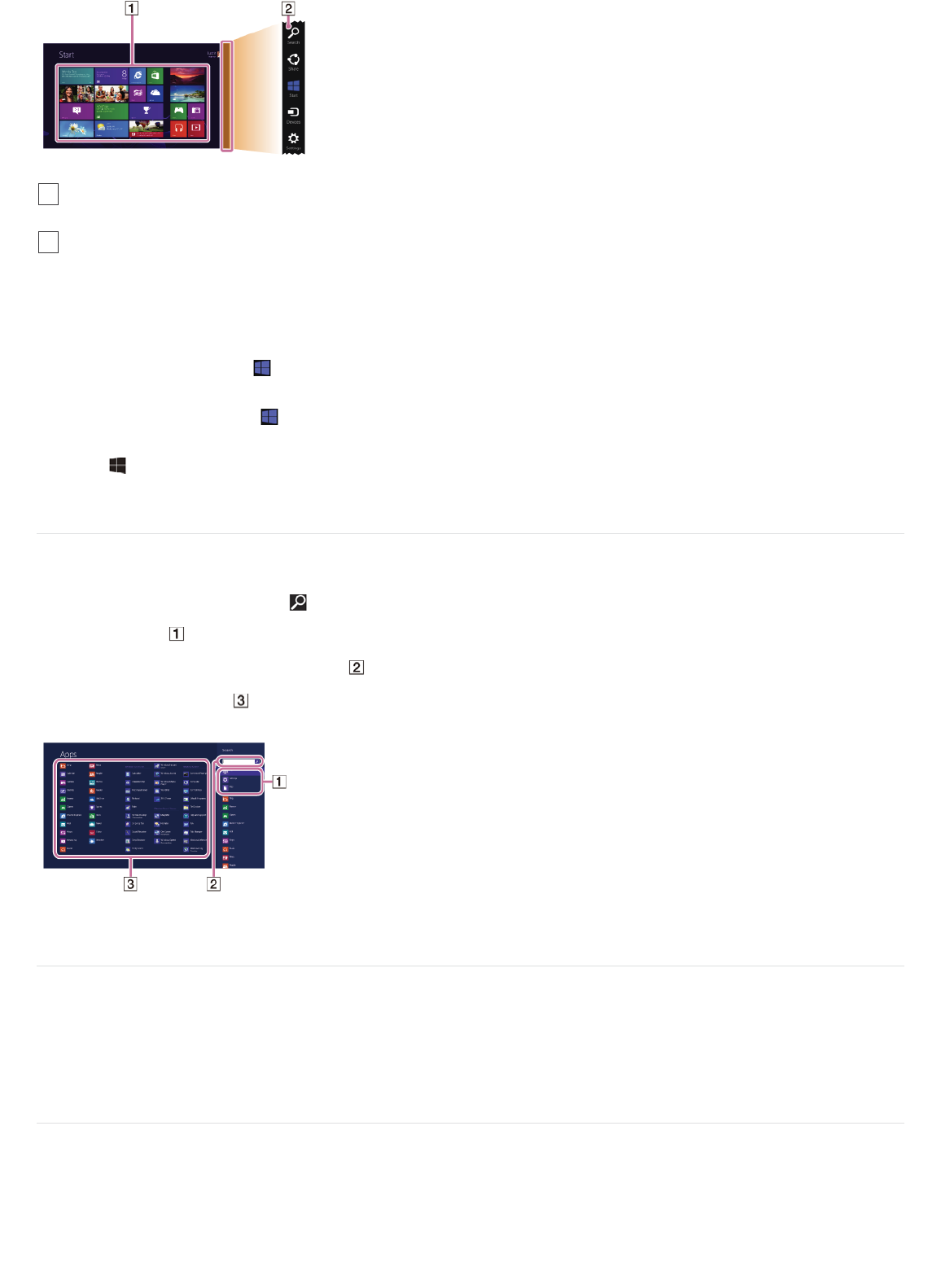
To open the Start screen
Touch operation (Touch screen equipped models)
Open the charms, then tap the Start charm. (See Opening the Charms to open the charms.)
Mouse/Touch pad operation
Open the charms, then click the Start charm. (See Opening the Charms to open the charms.)
Keyboard operation
Press the (Windows) key.
Opening Control Panel
You can open Control Panel by following these steps.
1. Open the charms and select the Search charm. (See Opening the Charms to open the charms.)
2. Select Apps ( ).
3. Enter "Control Panel" in the search box ( ).
4. Select Control Panel ( ).
Opening the Desktop
You can access the desktop from a tile, just like an app. Open the desktop by following the instruction below.
1. Open the Start screen and select the Desktop tile. (See About the Start Screen and Menu to open the Start screen.)
Opening the Charms
You can open the charms to search for apps and files, share content, play content on other devices or print, and set up your
VAIO computer.
Touch operation (Touch screen equipped models)
Swipe in from the right edge.
Tiles
Select a tile to start an app and personalize the Start screen by adding and rearranging tiles.
1
Charms
Search for apps and files, share content, play content on other devices or print, and set up your VAIO computer.
2

Mouse/Touch pad operation
Point to the upper-right corner ( ), then move downward ( ).
With a touch pad, you can also swipe in from the right edge.
Keyboard operation
Press the (Windows) key and the C key at the same time.
Controlling the Power State of Your VAIO Computer (Sleep Mode/Shutdown)
By default, your VAIO computer automatically enters Sleep mode after a certain period of inactivity.
In Sleep mode, the computer will retain its current state, including data you are working on, while you take a break.
See Using Sleep Mode for more information on Sleep mode.
When you do not use your VAIO computer for a while
To avoid losing unsaved data, follow these steps to shut down your VAIO computer.
1. Save your data and close all running apps.
2. Turn off any peripherals connected to your VAIO computer.
3. Open the charms, and then select the Settings charm. (See Opening the Charms to open the charms.)
4. Select Power and Shut down.
After a short time, your VAIO computer automatically turns off. If the computer is equipped with the power indicator, the
green power indicator light turns off.
If your VAIO computer is equipped with the power indicator, make sure it is off before closing the LCD screen lid.
Note
An improper shutdown may cause loss of unsaved data or cause your VAIO computer to malfunction.
To disconnect your VAIO computer completely from an AC power source, turn off the computer, and then unplug the power
cord from the AC outlet.
Hint
If you select Shut down while holding down the Shift key in step 4, you can place your VAIO computer into the minimum
power consumption state (ACPI S5 mode). In this case, the fast boot function is temporarily disabled on the next start-up.
Restarting Your VAIO Computer
After changing the settings or installing an app on your VAIO computer, you may be required to restart the computer.
1. Save your data and close all running apps.
2. Open the charms and select the Settings charm. (See Opening the Charms to open the charms.)
3. Select Power and Restart.
Your VAIO computer will restart.
Using Sleep Mode

In Sleep mode, you can step away from your VAIO computer while retaining the computer’s state including data you are
working on.
To activate Sleep mode
1. Open the charms and select the Settings charm. (See Opening the Charms to open the charms.)
2. Select Power and Sleep.
If your VAIO computer is equipped with the power indicator, it turns off when the computer enters Sleep mode (with the
default setting).
To return to Normal mode
1. Press the (Power) button.
Note
If you press and hold down the (Power) button for more than 4 or 10 seconds, your VAIO computer will turn off
automatically. Doing this will erase all unsaved data.
By default, your VAIO computer automatically enters Hibernate mode when the battery pack is running out of power.
However, depending on the operating conditions, the computer may fail to enter Hibernate mode.
If this occurs and the battery pack is running out of power, the computer will be turned off, resulting in loss of unsaved
data.
While the computer is running on battery power, save data frequently.
Before moving your VAIO computer, make sure that the computer is off to avoid impact or vibration to the running hard disk
drive. If the computer is equipped with the power indicator, make sure that it is completely off.
Hint
By default, your VAIO computer enters Sleep mode automatically after a certain period of inactivity while running on AC
power.
The operations below also place your VAIO computer into Sleep mode.
Press the (Power) button (with the default setting).
Close the LCD screen lid. The computer will enter Sleep mode after a few seconds.
You can restore your VAIO computer from Sleep mode to Normal mode by opening the LCD screen. (For SVF14N/SVF15N,
even if you open the LCD screen, the computer does not return to Normal mode 24 hours after the computer enters Sleep
mode.)
To change the action when you open the LCD screen, start VAIO Control Center and change the settings in Power and
Battery. To start VAIO Control Center, see Searching/Starting Apps, Settings, or Files.
Installing Apps from Windows Store
You can install apps from Windows Store.
You will need a Microsoft account to use certain apps or services, including Windows Store.
On how to create and what you can do with the Microsoft account, refer to Windows Help and Support (Opening Windows
Help and Support).
1. Connect to the Internet.
See Connecting to the Internet with a Wired Connection (LAN port equipped models) for more information on how to
connect to the Internet.
2. Open the Start screen and select the Store tile. (See About the Start Screen and Menu to open the Start screen.)
3. Find an app to install.
4. Follow the on-screen instructions to install the app.
Switching User Accounts
You can switch to another user account by following these steps.
1. Open the Start screen and select an account name at the upper-right corner of the computer screen. (See About the Start
Screen and Menu to open the Start screen.)
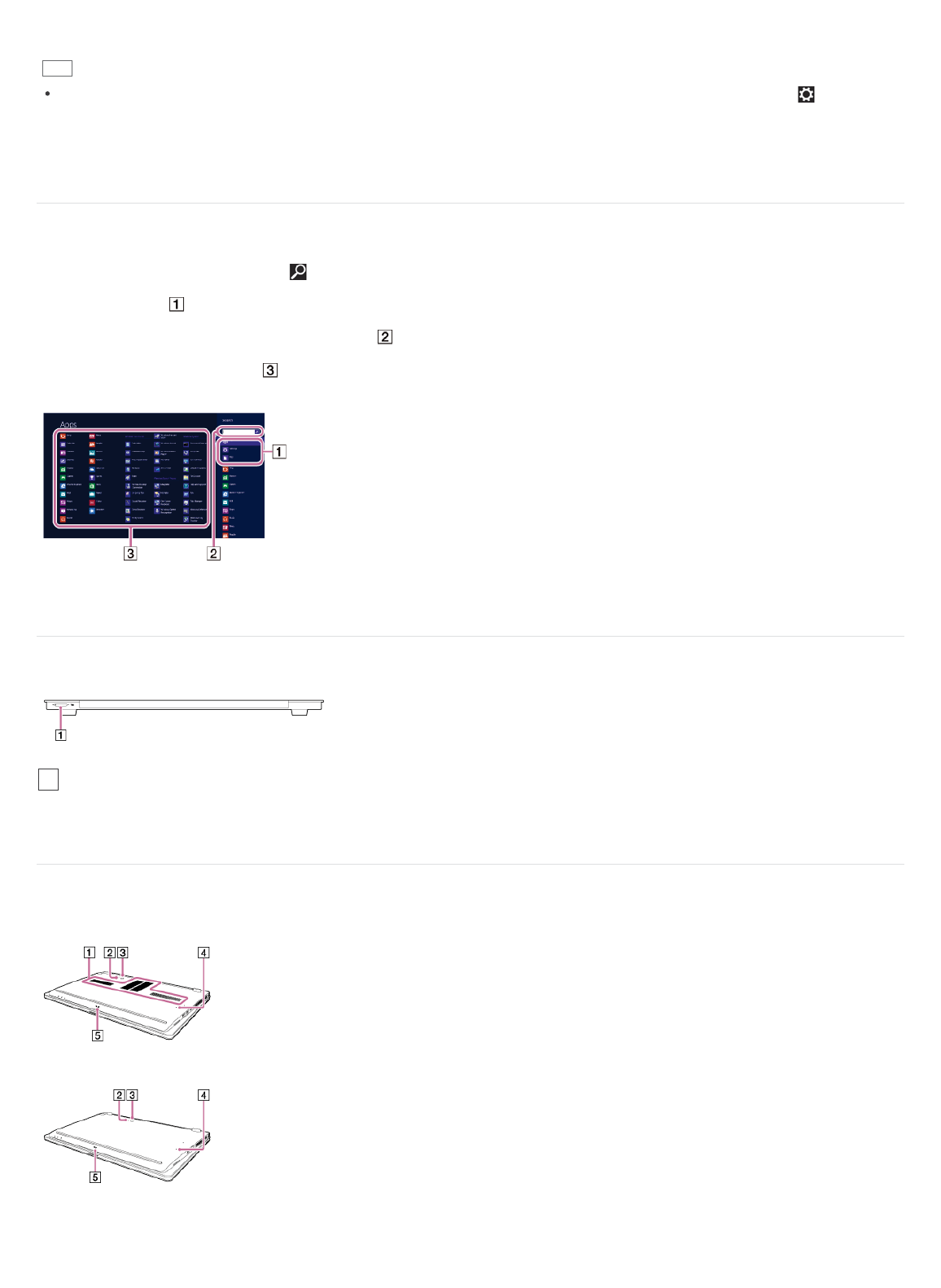
2. Select your desired account name.
Hint
To create a new user account, you need to sign in as an administrator. Then, open the charms and select the Settings
charm. Select Change PC settings in the lower right corner, and select Users in the left pane.
To open the charms, see Opening the Charms.
Opening Windows Help and Support
You can open Windows Help and Support by following these steps.
1. Open the charms and select the Search charm. (See Opening the Charms to open the charms.)
2. Select Apps ( ).
3. Enter "Help and Support" in the search box ( ).
4. Select Help and Support ( ).
Parts and Controls on the Back
Describes the features on the back of the VAIO computer, such as connection ports.
Parts and Controls on the Bottom
Describes the features on the bottom of the VAIO computer.
SVF15N
SVF14N
SVF13N
VOL (Volume) buttons
1
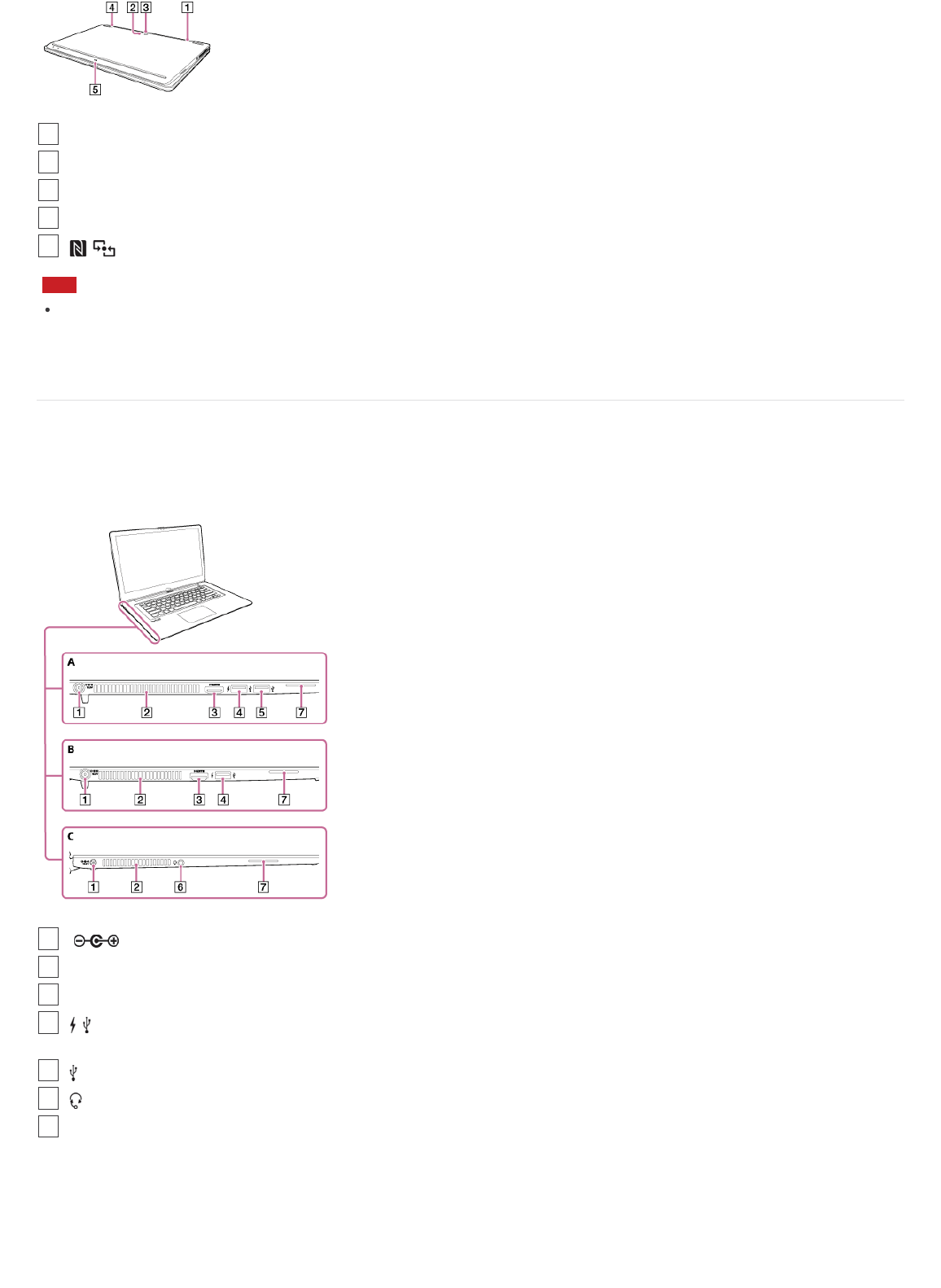
Note
If the battery off button is pressed while your VAIO computer is running, unsaved data may be lost. Be sure to save your
working data and turn off the computer before pressing the battery off button.
Parts and Controls on the Sides
Describes the features on the sides of the VAIO computer, such as connection ports.
A:SVF15N
B:SVF14N
C:SVF13N
A:SVF15N / SVF14N
B:SVF13N
Air intake vents
1
Built-in rear camera indicator (Built-in rear camera equipped models) (Using the Built-in Camera)
2
Built-in rear camera (Built-in rear camera equipped models) (Using the Built-in Camera)
3
Battery off button
4
Touch mark (NFC supported models) (Using NFC/One-touch functions (NFC supported models))
5
DC IN port (Connecting a Power Source)
1
Air exhaust vent
2
HDMI output port (Connecting a TV with an HDMI Input Port)
3
USB port (Connecting a USB Device)
This USB port supports USB charging. See Charging a USB Device for more information.
4
USB port (Connecting a USB Device)
5
Headset compatible headphone jack (Connecting External Speakers/Headphones/Headset)
6
Built-in speaker (stereo)
7
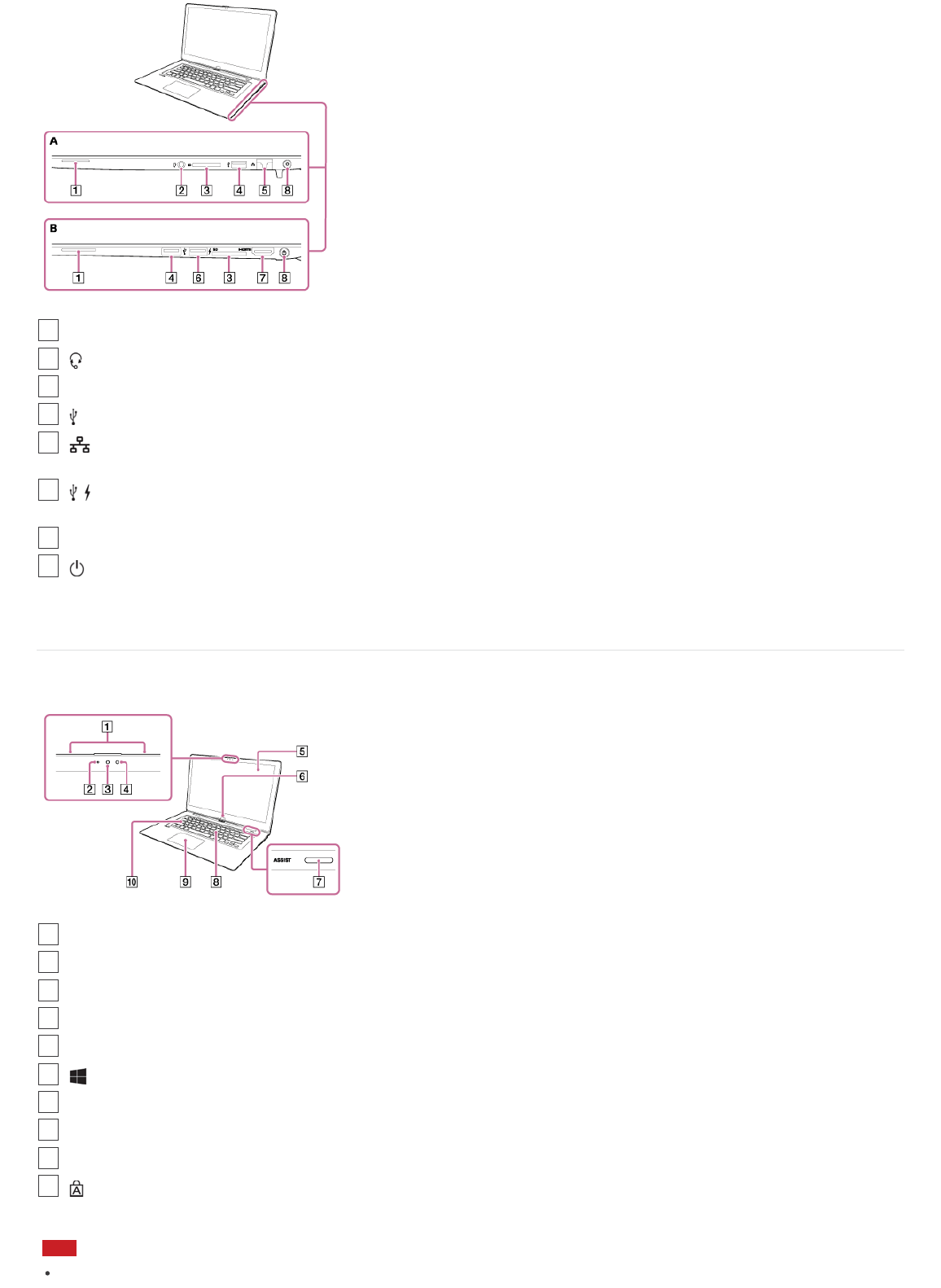
Parts and Controls on the Front
Describes the features on the front of the VAIO computer, such as buttons and indicator lights.
* The shape of the Windows button depends on the model.
Note
The magnets are built in around the touch screen, or the areas in front of the left and right corners of the keyboard
Built-in speaker (stereo)
1
Headset compatible headphone jack (Connecting External Speakers/Headphones/Headset)
2
SD memory card slot (Inserting SD Memory Cards)
3
USB port (Connecting a USB Device)
4
LAN port (Connecting to the Internet with a Wired Connection (LAN port equipped models))
For details on the LAN port, see Using the LAN Port (LAN port equipped models).
5
USB port (Connecting a USB Device)
This USB port supports USB charging. See Charging a USB Device for more information.
6
HDMI output port (Connecting a TV with an HDMI Input Port)
7
Power button (Turning On Your VAIO Computer)
8
Built-in dual microphones (Using the Built-in Camera)
1
Built-in front camera indicator (Using the Built-in Camera)
2
Built-in front camera (Using the Built-in Camera)
3
Ambient light sensor (Adjusting the LCD Brightness Automatically)
4
Touch screen (How to Use the Touch Screen (Touch screen equipped models))
5
Windows button*
6
ASSIST button (About the ASSIST Button)
7
Keyboard
8
Touch pad (Using the Touch Pad)
9
Caps lock indicator
10
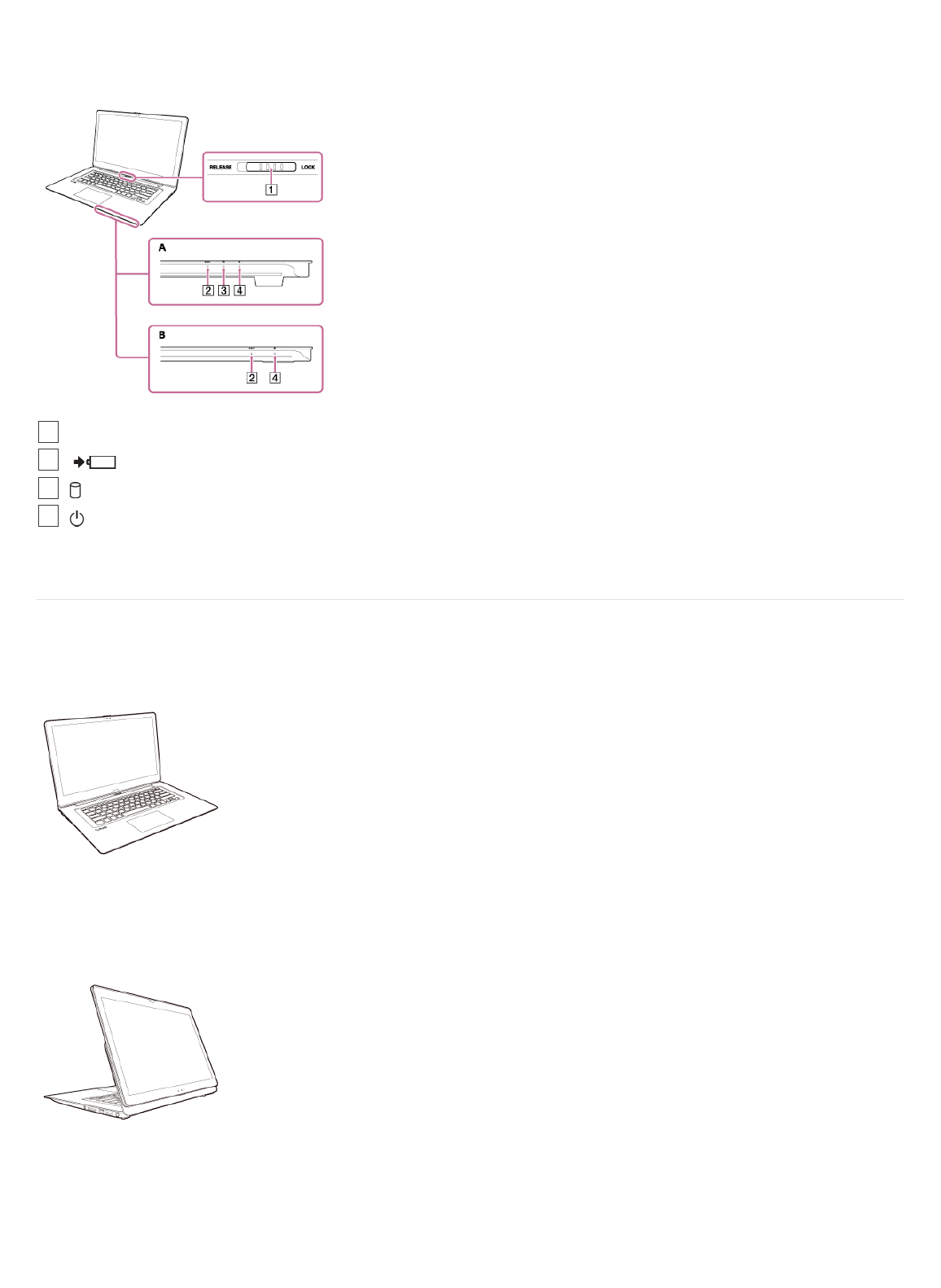
depending on the models. Do not place credit cards etc., which are affected by magnetism, near your VAIO computer. The
computer may cause data corruption.
A:SVF15N / SVF14N
B:SVF13N
About the LCD Screen Rotation
You can use your VAIO computer in three different modes by changing the LCD screen orientation.
Laptop Mode
Use this mode to enter characters with the keyboard.
Viewer Mode
Use this mode when you want to see only the computer screen during video playback so that you can concentrate on the video
content, or show the screen to the person in front of you. To change Laptop Mode to Viewer Mode, see Using Your VAIO
Computer in Viewer Mode.
Tablet Mode
Use this mode to operate your VAIO computer with the touch screen as a tablet. To change Laptop Mode to Tablet Mode, see
Using Your VAIO Computer in Tablet Mode.
Display lock switch
1
Charge indicator (Charge Indicator Status List)
2
Disc drive indicator (Disc drive indicator equipped models)
3
Power indicator (Turning On Your VAIO Computer)
4
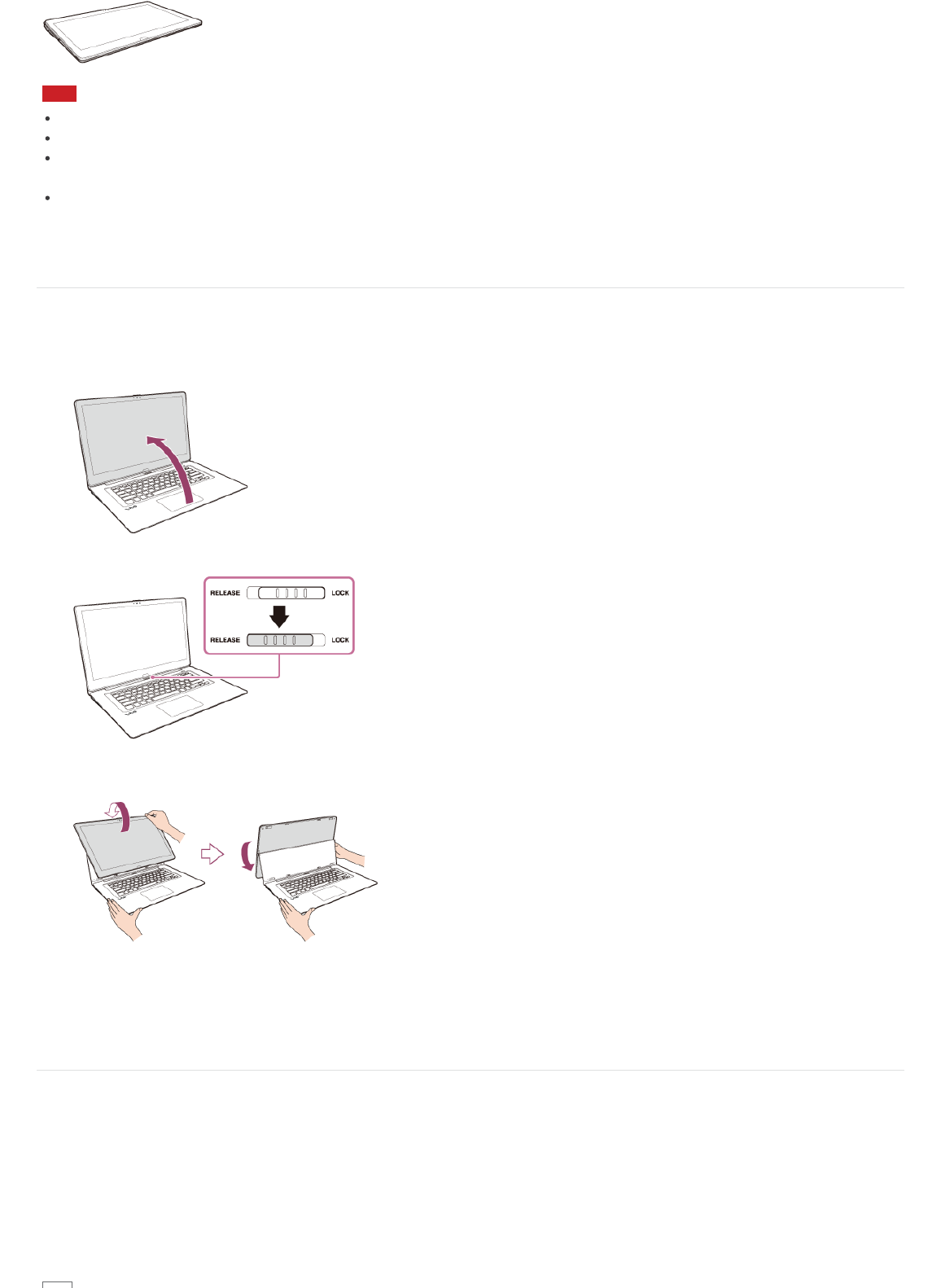
Note
Make sure the display lock switch is set to the LOCK position before using your VAIO computer in Laptop Mode.
Make sure your VAIO computer is in Laptop Mode and the LCD screen is closed when carrying the computer in a case.
If you change the LCD screen orientation during video playback, your VAIO computer may become unstable. Exit the video
playback app before changing the screen orientation.
The VAIO Care (Rescue Mode) screen appears upside down when your VAIO computer is in Viewer Mode. Be sure to
change Viewer Mode to Laptop Mode before using VAIO Care (Rescue Mode).
Using Your VAIO Computer in Viewer Mode
You can use your VAIO computer in Viewer Mode when you want to see only the computer screen during video playback so
that you can concentrate on the video content, or show the screen to the person in front of you.
1. Open the LCD screen more than 90 degrees.
2. Set the display lock switch to the RELEASE position.
3. Hold down the area in front of the keyboard with your hand, grasp the top corner of the LCD screen with the other hand,
and rotate the screen in the direction of the arrow.
To change back to Laptop Mode
Rotate the LCD screen to the front side of your VAIO computer and set the display lock switch to the LOCK position.
Checking Supplied Items
Check all items packed with the product before use.
AC adapter
Power cord
Digitizer stylus
(Not supplied with all models. Availability depends on your computer’s specifications.)
Wireless router
(Not supplied with all models. Availability depends on your computer’s specifications.)
VGA adapter
(Not supplied with all models. Availability depends on your computer’s specifications.)
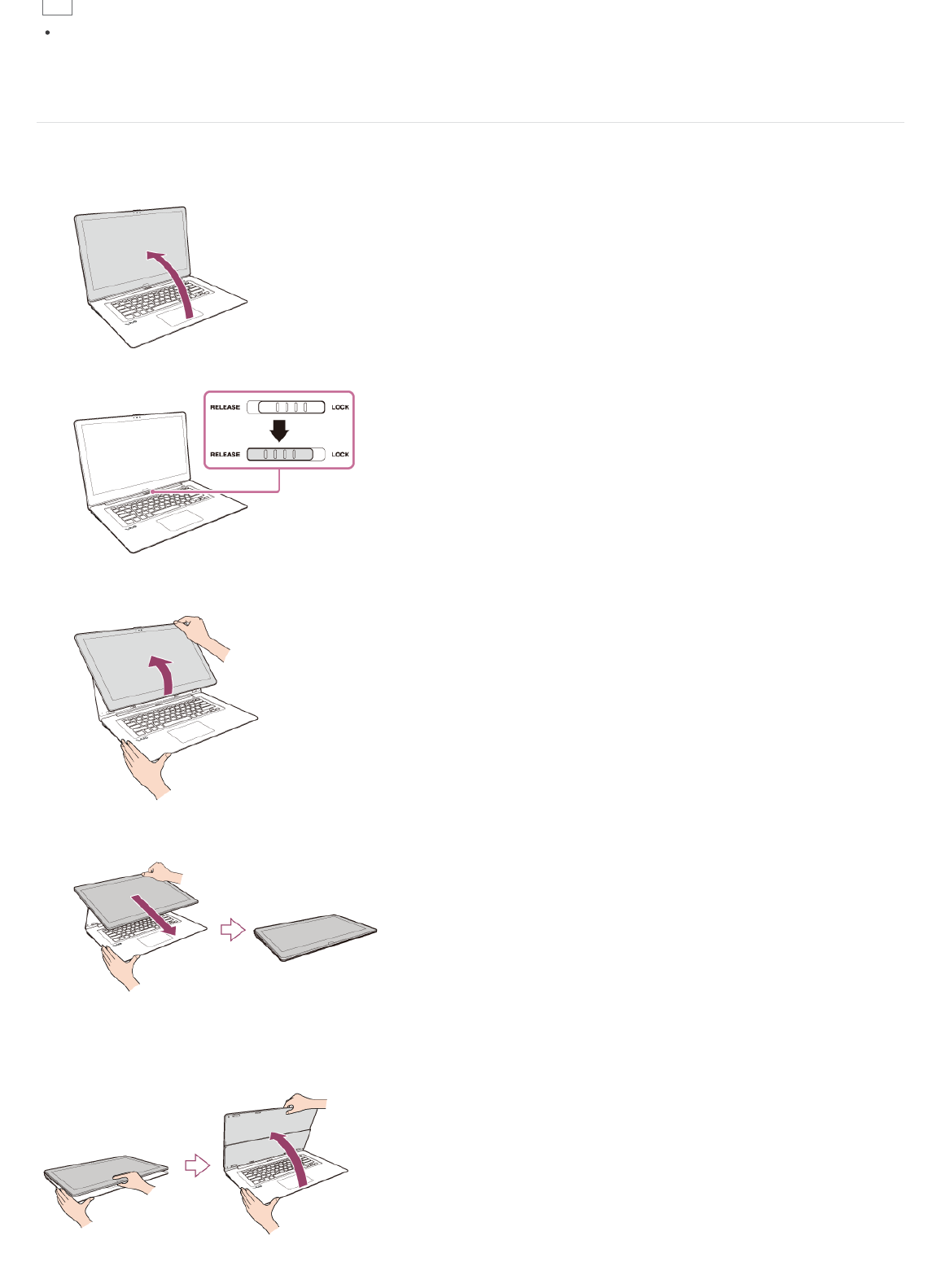
Hint
No Recovery Media is included because your VAIO computer can be recovered using data stored in the hard disk drive or
SSD. See Recovering from the Recovery Area for more information.
Using Your VAIO Computer in Tablet Mode
You can use your VAIO computer in Tablet Mode to operate the computer with the touch screen as a tablet.
1. Open the LCD screen more than 90 degrees.
2. Set the display lock switch to the RELEASE position.
3. Hold down the area in front of the keyboard with your hand, grasp the top corner of the LCD screen with the other hand,
and rotate the screen slightly to the back side of your VAIO computer.
4. Move the LCD screen in the direction of the arrow to fold the screen.
The LCD screen is folded on the keyboard.
To change back to Laptop Mode
Grasp the center of the LCD screen and raise the screen to change Tablet Mode to Viewer Mode. Then, rotate the screen to the
front side of your VAIO computer and set the display lock switch to the LOCK position.

Setting Up an Appropriate Work Environment
This topic describes where to or not to place your VAIO computer and ergonomic instructions.
Where to place your VAIO computer
When placing your VAIO computer, ensure that:
You have easy access to a power source and necessary ports.
You leave enough space around the computer.
The computer is placed on a flat surface that is wide enough and you can face the computer screen as you operate it.
You can place the computer in front of you where you can sit upright and keep your forearms parallel to the floor.
Where not to place your VAIO computer
Placing your VAIO computer in an inappropriate location may cause damage or a malfunction. Do not place the computer in a
location subject to:
Direct sunlight
Magnetic items or sources
Heat sources, such as residential heating equipment
Excessive dust
High humidity
Poor ventilation
Note
The area around the air exhaust vent may become extremely hot while your VAIO computer is on. Be careful before
touching the area.
Do not place any object near the air exhaust vent that may block the vent.
Hint
Your VAIO computer uses high-frequency radio signals and may cause interference to radio or TV reception. If this occurs,
move the computer a suitable distance away from the radio or TV.
Ergonomic considerations
Whenever possible, you should attempt to take account of the following ergonomic considerations.
Furniture and posture
Sit in a chair with good back support. Adjust the level of the chair so your feet are flat on the floor. A footrest may make you
more comfortable.
Sit in a relaxed, upright posture and avoid slouching forward or leaning far backwards.
Viewing angle of the computer screen
Use the screen tilting feature to find the best position. Make sure the computer screen is at or slightly below eye level when
you are sitting in front of your VAIO computer. Adjust the brightness level of the display as well.
You can reduce eye strain and muscle fatigue by adjusting the tilt and brightness level of the computer screen to the proper
position.
Lighting
Choose a location where windows and lights do not cause glare and reflection on the computer screen. Use indirect lighting to
avoid bright spots on the computer screen. Proper lighting adds to your comfort and work efficiency.
Note
While adjusting the viewing angle, do not exert excessive pressure on your VAIO computer to eliminate a risk of mechanical
damage.
Hint
The same considerations apply when you use an external display.
Notes on handling your VAIO computer
Observe the following to avoid malfunctions and damage to your VAIO computer.
Place your VAIO computer gently on a flat surface to avoid a mechanical shock.
Be sure to turn off your VAIO computer before moving the computer. Moving the computer that is turned on may cause a
hard disk malfunction. Be sure to disconnect all cables connected to the computer before moving it.
Do not drop or hit your VAIO computer. Even a slight shock or vibration may cause a hard disk malfunction.
Do not place your VAIO computer in an unstable position.
Connecting a Power Source

Connect your VAIO computer to an AC power source.
Carefully read the precautions in Notes on Using the Power Source before connection.
1. Plug one end of the power cord ( ) into the AC adapter ( ).
2. Plug the other end of the power cord into an AC outlet ( ).
3. Plug the cable from the AC adapter ( ) into the DC IN port ( ) on your VAIO computer.
Note
Do not plug more than one device into the same AC outlet.
The shape of the AC adapter varies depending on the model you purchased.
Make sure that the power plug is firmly plugged into your VAIO computer.
Hint
You can purchase a power strip with a surge protector to help prevent damage to your VAIO computer caused by sudden
power surges (in an electrical storm, for example).
Charging the Battery Pack
The battery pack can be charged even while you are using your VAIO computer when the computer is connected to a power
source. The charging time may vary depending on operating conditions.
1. Plug your VAIO computer into an AC outlet. (See Connecting a Power Source.)
Hint
The charging time varies depending on ambient temperature.
Note that at a low ambient temperature, it takes longer time to charge the battery pack.
Open the desktop and select the battery icon, such as (on battery) or (plugged in), in the desktop notification area to
check the built-in battery status of your VAIO computer. To open the desktop, see Opening the Desktop.
Turning On Your VAIO Computer
Turn on your VAIO computer to start Windows.
Carefully read the precautions in Notes on Using the Power Source before turning on.
1. Connect your VAIO computer to an AC outlet. (See Connecting a Power Source.)
2. Lift the LCD screen lid.
3. Press the (Power) button.
If your VAIO computer is equipped with the power indicator, it turns on in green.
The computer is turned on, and Windows starts after a while.
Note
If you press and hold down the (Power) button for more than four seconds, your VAIO computer will not turn on.
When moving the LCD screen, do not hold the built-in camera as it may cause your VAIO computer to malfunction.
If you press the (Power) button with the LCD screen lid closed, your VAIO computer will not turn on.
Do not touch the touch screen when turning on your VAIO computer as it may cause the computer to malfunction. (Touch
screen equipped models)
Hint
By default, your VAIO computer automatically enters Sleep mode after a certain period of inactivity while the computer is
connected to an AC outlet. See Using Sleep Mode for more information.
Controlling the Power State of Your VAIO Computer (Sleep Mode/Shutdown)
By default, your VAIO computer automatically enters Sleep mode after a certain period of inactivity.

In Sleep mode, the computer will retain its current state, including data you are working on, while you take a break.
See Using Sleep Mode for more information on Sleep mode.
When you do not use your VAIO computer for a while
To avoid losing unsaved data, follow these steps to shut down your VAIO computer.
1. Save your data and close all running apps.
2. Turn off any peripherals connected to your VAIO computer.
3. Open the charms, and then select the Settings charm. (See Opening the Charms to open the charms.)
4. Select Power and Shut down.
After a short time, your VAIO computer automatically turns off. If the computer is equipped with the power indicator, the
green power indicator light turns off.
If your VAIO computer is equipped with the power indicator, make sure it is off before closing the LCD screen lid.
Note
An improper shutdown may cause loss of unsaved data or cause your VAIO computer to malfunction.
To disconnect your VAIO computer completely from an AC power source, turn off the computer, and then unplug the power
cord from the AC outlet.
Hint
If you select Shut down while holding down the Shift key in step 4, you can place your VAIO computer into the minimum
power consumption state (ACPI S5 mode). In this case, the fast boot function is temporarily disabled on the next start-up.
Charging the Battery Pack
The battery pack can be charged even while you are using your VAIO computer when the computer is connected to a power
source. The charging time may vary depending on operating conditions.
1. Plug your VAIO computer into an AC outlet. (See Connecting a Power Source.)
Hint
The charging time varies depending on ambient temperature.
Note that at a low ambient temperature, it takes longer time to charge the battery pack.
Open the desktop and select the battery icon, such as (on battery) or (plugged in), in the desktop notification area to
check the built-in battery status of your VAIO computer. To open the desktop, see Opening the Desktop.
Notes on Using the Battery Pack
Before using the battery pack, read the following precautions for correct use.
About the battery pack
The battery pack built in your VAIO computer is not removable.
For safety reasons, battery charging may be suspended at higher or lower temperatures.
The battery pack is not fully charged at the time of delivery.
While the battery pack is in use or being charged, heat builds up in the battery pack. This is normal and is not cause for
concern.
About battery discharge
After battery charge, the battery pack will gradually discharge over time even while not in use. If it is left unused for an
extended period of time, the battery power may be depleted. It is recommended that you recharge the battery pack before
use.
About battery life
Battery life varies depending on usage and settings.
About battery deterioration and replacement
The battery pack is consumable. The capacity gradually declines through repeated cycles of recharging and discharging, and
depending on the ambient temperature during use or storage. As a result, the battery life becomes short even if it is fully
charged and eventually the battery pack reaches the end of its life.

If the battery pack quickly runs out of power after being fully charged or it has reached the end of its life, replace it with a
new one.
Contact an authorized Sony service/support center and replace the battery pack with a new one specified by Sony.
When the battery pack is running out of power
If the battery pack runs out and your VAIO computer is not plugged in, power will be cut off and any data you are working on
will be lost.
While your VAIO computer is running on battery power, save data frequently.
About the LCD Screen Rotation
You can use your VAIO computer in three different modes by changing the LCD screen orientation.
Laptop Mode
Use this mode to enter characters with the keyboard.
Viewer Mode
Use this mode when you want to see only the computer screen during video playback so that you can concentrate on the video
content, or show the screen to the person in front of you. To change Laptop Mode to Viewer Mode, see Using Your VAIO
Computer in Viewer Mode.
Tablet Mode
Use this mode to operate your VAIO computer with the touch screen as a tablet. To change Laptop Mode to Tablet Mode, see
Using Your VAIO Computer in Tablet Mode.
Note
Make sure the display lock switch is set to the LOCK position before using your VAIO computer in Laptop Mode.
Make sure your VAIO computer is in Laptop Mode and the LCD screen is closed when carrying the computer in a case.
If you change the LCD screen orientation during video playback, your VAIO computer may become unstable. Exit the video
playback app before changing the screen orientation.
The VAIO Care (Rescue Mode) screen appears upside down when your VAIO computer is in Viewer Mode. Be sure to
change Viewer Mode to Laptop Mode before using VAIO Care (Rescue Mode).
Using Your VAIO Computer in Viewer Mode
You can use your VAIO computer in Viewer Mode when you want to see only the computer screen during video playback so
that you can concentrate on the video content, or show the screen to the person in front of you.
1. Open the LCD screen more than 90 degrees.
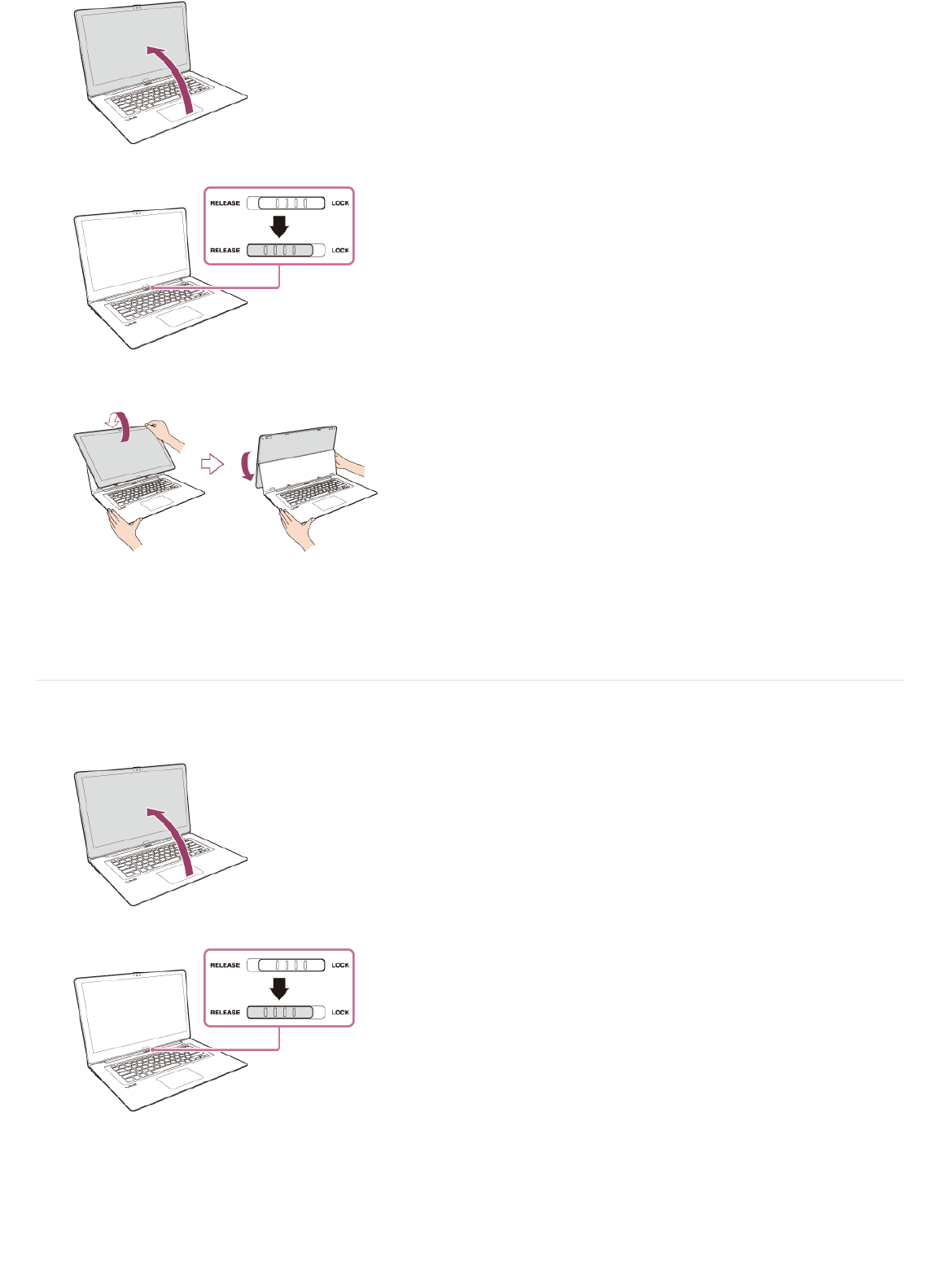
2. Set the display lock switch to the RELEASE position.
3. Hold down the area in front of the keyboard with your hand, grasp the top corner of the LCD screen with the other hand,
and rotate the screen in the direction of the arrow.
To change back to Laptop Mode
Rotate the LCD screen to the front side of your VAIO computer and set the display lock switch to the LOCK position.
Using Your VAIO Computer in Tablet Mode
You can use your VAIO computer in Tablet Mode to operate the computer with the touch screen as a tablet.
1. Open the LCD screen more than 90 degrees.
2. Set the display lock switch to the RELEASE position.
3. Hold down the area in front of the keyboard with your hand, grasp the top corner of the LCD screen with the other hand,
and rotate the screen slightly to the back side of your VAIO computer.
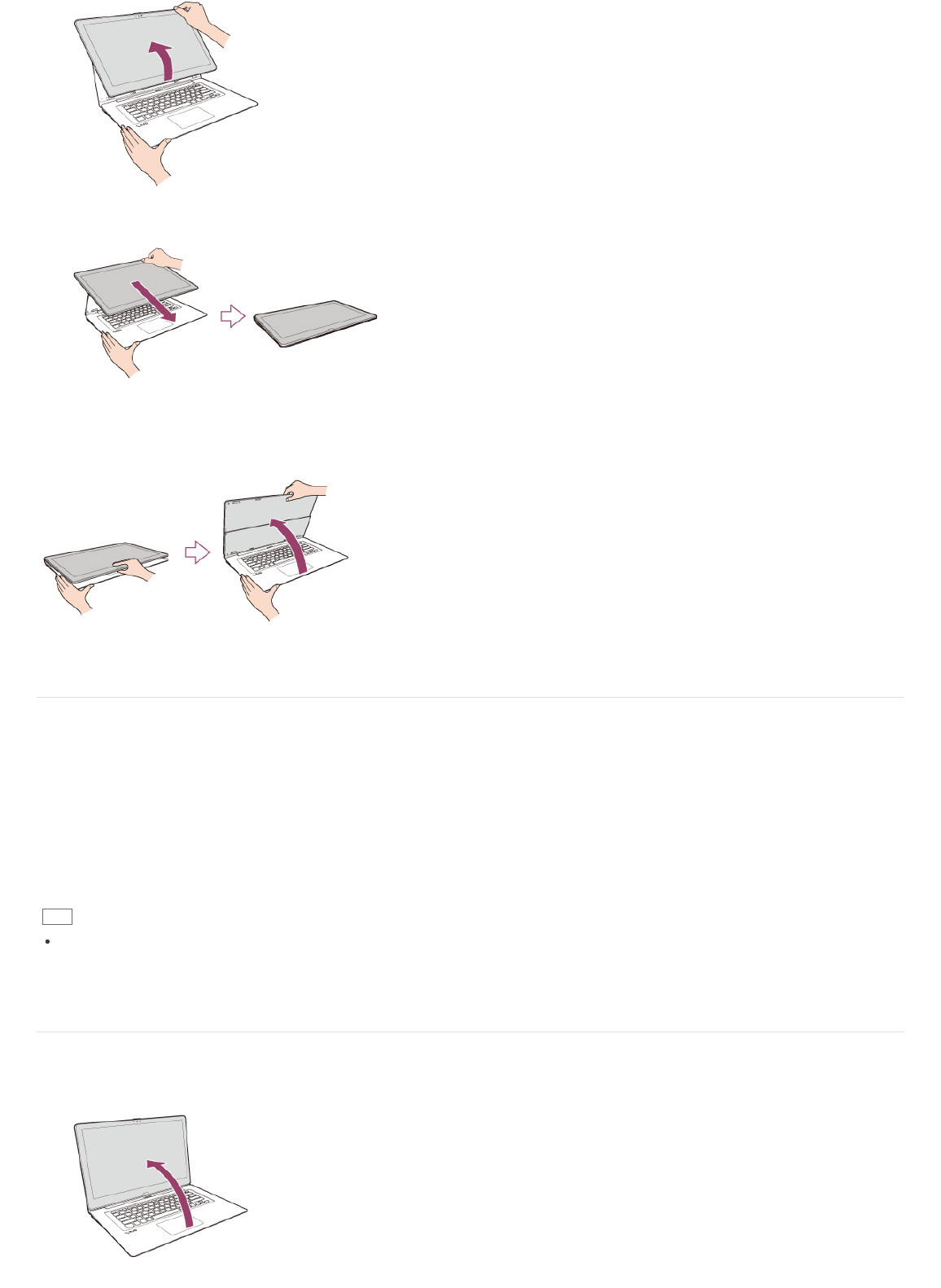
4. Move the LCD screen in the direction of the arrow to fold the screen.
The LCD screen is folded on the keyboard.
To change back to Laptop Mode
Grasp the center of the LCD screen and raise the screen to change Tablet Mode to Viewer Mode. Then, rotate the screen to the
front side of your VAIO computer and set the display lock switch to the LOCK position.
Checking Supplied Items
Check all items packed with the product before use.
AC adapter
Power cord
Digitizer stylus
(Not supplied with all models. Availability depends on your computer’s specifications.)
Wireless router
(Not supplied with all models. Availability depends on your computer’s specifications.)
VGA adapter
(Not supplied with all models. Availability depends on your computer’s specifications.)
Hint
No Recovery Media is included because your VAIO computer can be recovered using data stored in the hard disk drive or
SSD. See Recovering from the Recovery Area for more information.
Using Your VAIO Computer in Tablet Mode
You can use your VAIO computer in Tablet Mode to operate the computer with the touch screen as a tablet.
1. Open the LCD screen more than 90 degrees.
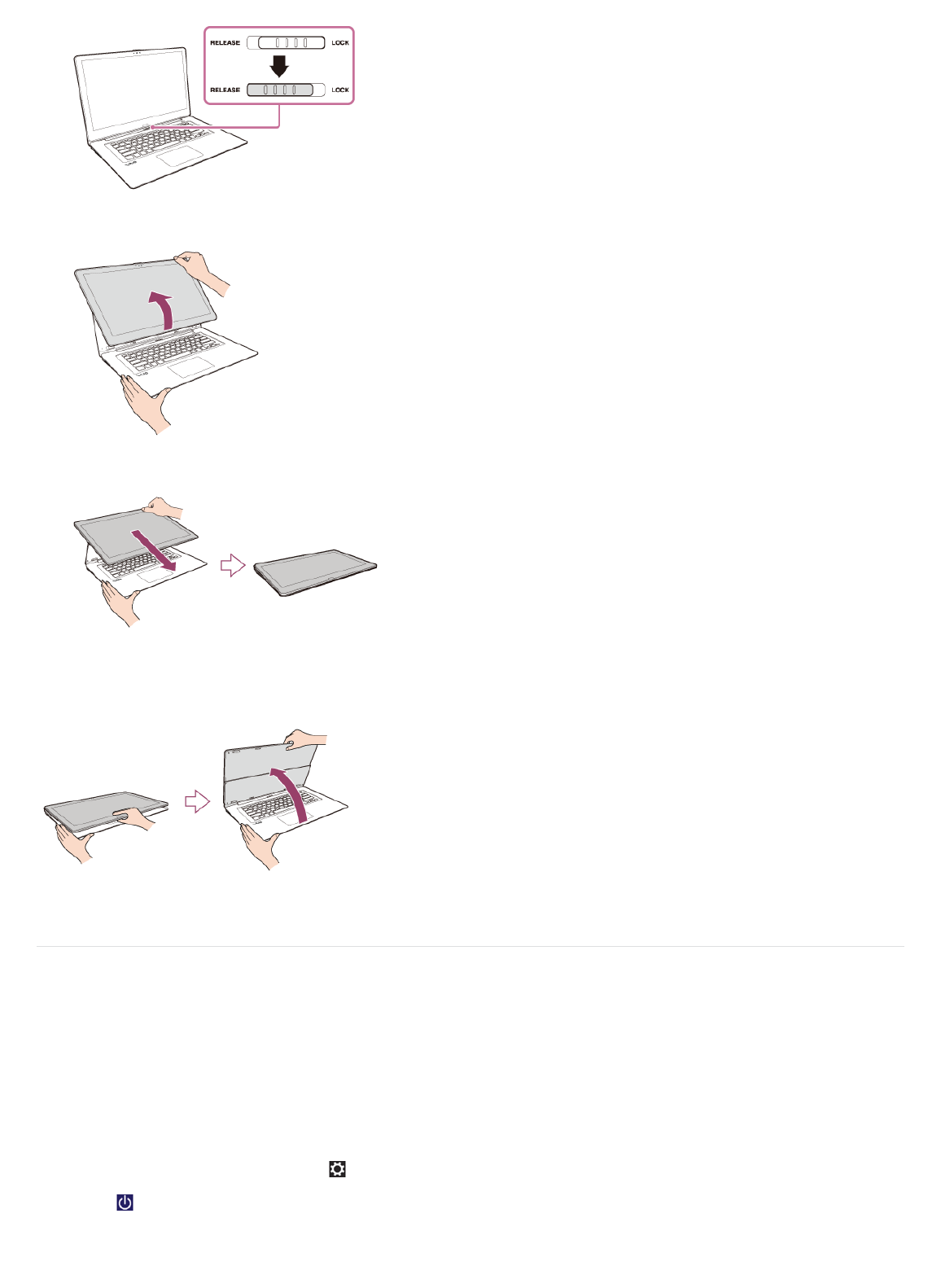
2. Set the display lock switch to the RELEASE position.
3. Hold down the area in front of the keyboard with your hand, grasp the top corner of the LCD screen with the other hand,
and rotate the screen slightly to the back side of your VAIO computer.
4. Move the LCD screen in the direction of the arrow to fold the screen.
The LCD screen is folded on the keyboard.
To change back to Laptop Mode
Grasp the center of the LCD screen and raise the screen to change Tablet Mode to Viewer Mode. Then, rotate the screen to the
front side of your VAIO computer and set the display lock switch to the LOCK position.
Controlling the Power State of Your VAIO Computer (Sleep Mode/Shutdown)
By default, your VAIO computer automatically enters Sleep mode after a certain period of inactivity.
In Sleep mode, the computer will retain its current state, including data you are working on, while you take a break.
See Using Sleep Mode for more information on Sleep mode.
When you do not use your VAIO computer for a while
To avoid losing unsaved data, follow these steps to shut down your VAIO computer.
1. Save your data and close all running apps.
2. Turn off any peripherals connected to your VAIO computer.
3. Open the charms, and then select the Settings charm. (See Opening the Charms to open the charms.)
4. Select Power and Shut down.
After a short time, your VAIO computer automatically turns off. If the computer is equipped with the power indicator, the
green power indicator light turns off.
If your VAIO computer is equipped with the power indicator, make sure it is off before closing the LCD screen lid.

Note
An improper shutdown may cause loss of unsaved data or cause your VAIO computer to malfunction.
To disconnect your VAIO computer completely from an AC power source, turn off the computer, and then unplug the power
cord from the AC outlet.
Hint
If you select Shut down while holding down the Shift key in step 4, you can place your VAIO computer into the minimum
power consumption state (ACPI S5 mode). In this case, the fast boot function is temporarily disabled on the next start-up.
Using the Antivirus App for Your VAIO Computer
Protect your VAIO computer against computer viruses by using the antivirus app.
You can keep the antivirus app current with the latest updates by downloading and installing the updates from the website of
the app publisher. To update the antivirus app, find the antivirus app installed on your VAIO computer from the following and
follow these steps.
1. Make sure your VAIO computer is connected to the Internet.
2. Perform any of these operations according to the preinstalled antivirus app.
For Trend Micro:
Start Trend Micro Titanium Maximum Security.
For McAfee:
Start McAfee LiveSafe - Internet Security,McAfee Internet Security, or McAfee Total Protection.
For Kaspersky Internet Security:
Start Kaspersky Internet Security.
3. Follow the on-screen instructions.
Note
The actual procedure may be different from the above depending on the version of the app installed on your VAIO computer.
In such a case, follow the on-screen instructions.
Hint
To start the antivirus app, see Searching/Starting Apps, Settings, or Files.
Refer to the help file included with your app for more information.
Connecting to the Internet with a Wired Connection (LAN port equipped models)
Before using the Internet, you need to sign up with an Internet Service Provider (ISP) and set up devices required for
connecting your VAIO computer to the Internet.
Connect one end of a LAN cable (not supplied) to the LAN port on your VAIO computer and the other end to your network.
Note
For detailed information on devices required for Internet access and how to connect your VAIO computer to the Internet, ask
your ISP.
When connecting your VAIO computer to the Internet, be sure to use a cable with “Network” or “Ethernet” writing on it.
Do not plug a telephone cable into the LAN port on your VAIO computer.
If the LAN port is connected to the following networks or telephone lines, high electric current to the port may cause
damage, overheating, or fire.
Any network, except 1000BASE-T/100BASE-TX/10BASE-T type networks
Public telephone subscriber line
Private branch exchange (PBX)
Home (intercom speakerphone) or business-use telephone lines (multi-line business telephone)
Hint
To connect your VAIO computer to the Internet using the Wi-Fi(R) (Wireless LAN) function, you need to set up the Wi-Fi

settings. See Starting Wi-Fi(R) (Wireless LAN) Communications for more information.
About the Internet Connection Services
The following types of Internet connection services are available.
You can select from among the services according to your preference, for example, communication speed or a usage fee. For
detailed information on a variety of connection services, contact Internet Service Providers (ISPs).
Fiber to the Home (FTTH)
Cable modem
Digital Subscriber Line (DSL)
Satellite
Dial-up
About the Network (LAN) - (not for SVF13N model)
The network (LAN) enables you to connect your VAIO computer to the Internet and transfer data between the computer and
other devices.
You can connect your VAIO computer to 1000BASE-T/100BASE-TX/10BASE-T type networks with a LAN cable (not supplied).
Connect one end of a LAN cable to the LAN port on the computer and the other end to your network. (LAN port equipped
models)
You can also connect your VAIO computer to a network using the Wi-Fi(R) (Wireless LAN) function.
For information on peripheral devices required for LAN access, ask your Internet Service Provider (ISP) or refer to the manual
that came with your modem.
For information on how to connect your VAIO computer to the network, refer to your ISP’s instructions or the manual that
came with the modem and other peripheral devices. If you require information on the network settings at your workplace, ask
the network administrator.
Disabling the Wi-Fi(R) (Wireless LAN) Function
You can disable the Wi-Fi function by following these steps.
1. Open the charms and select the Settings charm. (See Opening the Charms to open the charms.)
2. Select Change PC settings in the lower right corner.
3. Select Wireless in the left pane of the PC settings screen.
4. Change the Wi-Fi setting under Wireless devices to Off.
Hint
To enable the Wi-Fi function, turn off Airplane mode and change the Wi-Fi setting under Wireless devices to On.
To disable all wireless functions, turn on Airplane mode.
The wireless function(s) whose setting is on will be enabled when you turn off Airplane mode.
Refer to Windows Help and Support (Opening Windows Help and Support) for more information on Airplane mode.
Notes on Using the Wi-Fi(R) (Wireless LAN) Function
Before using the Wi-Fi function, read the following precautions for correct use.
In some countries or regions, using the Wi-Fi products may be restricted by the local regulations.
Wi-Fi devices work on the 2.4 GHz band, which is used by a variety of devices. They use the technology to minimize radio
interference from other devices that use the same band; however, radio interference may still slow communication speeds,
reduce communication range, or cause communication failure.
If both the BLUETOOTH function and the 2.4 GHz Wi-Fi function of your VAIO computer are enabled, interference may occur
and cause slower communication speeds or other problems.
To communicate via Wi-Fi while you are on the road, you may need to contract with a Wi-Fi connection service provider.
If your VAIO computer is equipped with the IEEE 802.11a/b/g/n standard, outdoor use of the 5 GHz Wi-Fi function is
prohibited by law.
The communication speed and range may vary depending on the following conditions:

Distance between devices
Existence of obstacles between devices
Device configuration
Radio conditions
Ambient environment (including wall material, etc.)
Apps in use
Communications may be cut off depending on radio conditions.
The data transfer rate specified in the specification is the theoretical maximum, and may not reflect actual data transfer
rate.
Actual communication speed may not be as fast as the one displayed on your VAIO computer.
The 2.4 GHz and 5 GHz Wi-Fi frequency bands are not communicable with one another.
The data transfer rate of IEEE 802.11g and IEEE 802.11n (2.4 GHz) may be affected by interference when used with an IEEE
802.11b product. Also, IEEE 802.11g and IEEE 802.11n automatically lower the transfer rate to maintain compatibility with
an IEEE 802.11b product. The transfer rate may be regained by changing the channel settings of your access point.
To stop the Wi-Fi function abruptly, turn off your VAIO computer and the wireless devices (if any).
The WLAN standard includes the encryption methods: Wired Equivalent Privacy (WEP), which is a security protocol, Wi-Fi
Protected Access 2 (WPA2), and Wi-Fi Protected Access (WPA). Proposed jointly by the IEEE and Wi-Fi Alliance, both WPA2
and WPA are specifications of standards based on interoperable security enhancements that increase the level of data
protection and access control for existing Wi-Fi networks. WPA is designed to be forward compatible with the IEEE 802.11i
specification. It utilizes the enhanced data encryption Temporal Key Integrity Protocol (TKIP) in addition to user
authentication using 802.1X and Extensible Authentication Protocol (EAP). Data encryption protects the vulnerable wireless
link between clients and access points. Besides that, there are other typical LAN security mechanisms to ensure privacy,
such as: password protection, end-to-end encryption, virtual private networks, and authentication. WPA2, the second
generation of WPA, provides stronger data protection and network access control and is also designed to secure all versions
of 802.11 devices, including 802.11b, 802.11a, 802.11g, 802.11n, and 802.11ac (draft) standards, multi-band and multi-
mode. In addition, based on the ratified IEEE 802.11i standard, WPA2 provides government grade security by implementing
the National Institute of Standards and Technology (NIST) FIPS 140-2 compliant AES encryption algorithm and 802.1X-
based authentication. WPA2 is backward compatible with WPA.
Stopping Wi-Fi(R) (Wireless LAN) Communications
You can stop Wi-Fi communications by following these steps.
1. Open the charms and select the Settings charm. (See Opening the Charms to open the charms.)
2. Select (the network icon).
3. Select the desired access point and Disconnect.
Note
Do not disable the Wi-Fi function while accessing remote documents, files, or resources, as it may result in data loss.
About the Wi-Fi(R) (Wireless LAN) Standards
Wi-Fi allows your VAIO computer to connect to a network through a wireless connection.
Wi-Fi uses the following IEEE 802.11a/b/g/n/ac (draft) standard, which specifies the type of technology used. Refer to the
specifications to find out about the configuration of the computer.
IEEE 802.11a (Frequency band:5 GHz)
Exclusive to models compliant with the IEEE 802.11a/b/g/n/ac (draft) standard.
IEEE 802.11b/g (Frequency band:2.4 GHz)
The IEEE 802.11g standard provides higher-speed communications than the IEEE 802.11b.
IEEE 802.11n (Frequency band:2.4 GHz/5 GHz)
For models compliant with the IEEE 802.11b/g/n standard, only 2.4 GHz band can be used.
IEEE 802.11ac (draft) (Frequency band:5 GHz)
Exclusive to models compliant with the IEEE 802.11a/b/g/n/ac (draft) standard.
Installing Apps from Windows Store
You can install apps from Windows Store.
You will need a Microsoft account to use certain apps or services, including Windows Store.

On how to create and what you can do with the Microsoft account, refer to Windows Help and Support (Opening Windows
Help and Support).
1. Connect to the Internet.
See Connecting to the Internet with a Wired Connection (LAN port equipped models) for more information on how to
connect to the Internet.
2. Open the Start screen and select the Store tile. (See About the Start Screen and Menu to open the Start screen.)
3. Find an app to install.
4. Follow the on-screen instructions to install the app.
Starting Wi-Fi(R) (Wireless LAN) Communications
You can establish Wi-Fi communications between your VAIO computer and an access point (not supplied).
Before using Wi-Fi, make sure a Wi-Fi access point is on and operating.
1. Connect an access point to your VAIO computer.
Refer to Windows Help and Support (Opening Windows Help and Support) and the manual that came with the access
point for more information.
2. Open the charms and select the Settings charm. (See Opening the Charms to open the charms.)
3. Select Change PC settings in the lower right corner.
4. Select Wireless in the left pane of the PC settings screen.
5. Change Airplane mode to Off and the Wi-Fi setting under Wireless devices to On.
6. Open the charms and select the Settings charm. (See Opening the Charms to open the charms.)
7. Select (the network icon).
8. Select the desired access point and Connect.
After the connection is established, Connected appears in the selected wireless access point field.
If a security key entry window appears, enter the security key as required and select OK. See About a Security Key for
Wi-Fi(R) (Wireless LAN) for more information.
Note that security keys are case-sensitive.
To check Wi-Fi connection status
Open the desktop and move the mouse pointer over (the Network icon) in the desktop notification area to check the Wi-Fi
connection status, such as the access point currently connected to your VAIO computer.
To open the desktop, see Opening the Desktop.
Note
On IEEE 802.11a/b/g/n/ac (draft) equipped models, when only the 2.4 GHz Wi-Fi function is enabled, your VAIO computer
cannot connect to a 5 GHz Wi-Fi access point. Also, when only the 5 GHz Wi-Fi function is enabled, the computer cannot
connect to a 2.4 GHz Wi-Fi access point.
On IEEE 802.11b/g/n equipped models, when the 2.4 GHz Wi-Fi function is disabled, the computer cannot connect to an
access point. Also, the computer cannot connect to a 5 GHz Wi-Fi access point.
It may take some time to find and connect to a Wi-Fi access point before starting communications via Wi-Fi.
Hint
Refer to Windows Help and Support (Opening Windows Help and Support) for more information on Airplane mode.
Once you connect your VAIO computer to the access point by entering the security key, the access point will be registered in
the computer. You do not have to enter the security key for subsequent connections.
About a Security Key for Wi-Fi(R) (Wireless LAN)
A security key is a security protocol for Wi-Fi that encrypts data transmitted on Wi-Fi. It is also referred to as an encryption

key or a WEP (Wired Equivalent Privacy) key.
The security key allows wireless devices that have the same key, such as a Wi-Fi access point and a computer, to
communicate with each other on Wi-Fi.
The security key is assigned to each access point by default. (Make sure the default security key has been changed to protect
data from unauthorized use.) If you cannot find the default security key, refer to the manual that came with your access point.
If you enter a wrong security key, follow these steps to re-enter the security key.
1. Open the charms and select the Settings charm. (See Opening the Charms to open the charms.)
2. Select (the network icon).
3. Right-click the desired network and select View connection properties.
4. Select the Security tab.
5. Enter a security key in the Network security key field and select OK.
Connecting to the Internet with a Wired Connection (LAN port equipped models)
Before using the Internet, you need to sign up with an Internet Service Provider (ISP) and set up devices required for
connecting your VAIO computer to the Internet.
Connect one end of a LAN cable (not supplied) to the LAN port on your VAIO computer and the other end to your network.
Note
For detailed information on devices required for Internet access and how to connect your VAIO computer to the Internet, ask
your ISP.
When connecting your VAIO computer to the Internet, be sure to use a cable with “Network” or “Ethernet” writing on it.
Do not plug a telephone cable into the LAN port on your VAIO computer.
If the LAN port is connected to the following networks or telephone lines, high electric current to the port may cause
damage, overheating, or fire.
Any network, except 1000BASE-T/100BASE-TX/10BASE-T type networks
Public telephone subscriber line
Private branch exchange (PBX)
Home (intercom speakerphone) or business-use telephone lines (multi-line business telephone)
Hint
To connect your VAIO computer to the Internet using the Wi-Fi(R) (Wireless LAN) function, you need to set up the Wi-Fi
settings. See Starting Wi-Fi(R) (Wireless LAN) Communications for more information.
About the Internet Connection Services
The following types of Internet connection services are available.
You can select from among the services according to your preference, for example, communication speed or a usage fee. For
detailed information on a variety of connection services, contact Internet Service Providers (ISPs).
Fiber to the Home (FTTH)
Cable modem
Digital Subscriber Line (DSL)
Satellite
Dial-up
About the Network (LAN) - (not for SVF13N model)
The network (LAN) enables you to connect your VAIO computer to the Internet and transfer data between the computer and
other devices.
You can connect your VAIO computer to 1000BASE-T/100BASE-TX/10BASE-T type networks with a LAN cable (not supplied).
Connect one end of a LAN cable to the LAN port on the computer and the other end to your network. (LAN port equipped
models)
You can also connect your VAIO computer to a network using the Wi-Fi(R) (Wireless LAN) function.

For information on peripheral devices required for LAN access, ask your Internet Service Provider (ISP) or refer to the manual
that came with your modem.
For information on how to connect your VAIO computer to the network, refer to your ISP’s instructions or the manual that
came with the modem and other peripheral devices. If you require information on the network settings at your workplace, ask
the network administrator.
About the Wi-Fi(R) (Wireless LAN) Standards
Wi-Fi allows your VAIO computer to connect to a network through a wireless connection.
Wi-Fi uses the following IEEE 802.11a/b/g/n/ac (draft) standard, which specifies the type of technology used. Refer to the
specifications to find out about the configuration of the computer.
IEEE 802.11a (Frequency band:5 GHz)
Exclusive to models compliant with the IEEE 802.11a/b/g/n/ac (draft) standard.
IEEE 802.11b/g (Frequency band:2.4 GHz)
The IEEE 802.11g standard provides higher-speed communications than the IEEE 802.11b.
IEEE 802.11n (Frequency band:2.4 GHz/5 GHz)
For models compliant with the IEEE 802.11b/g/n standard, only 2.4 GHz band can be used.
IEEE 802.11ac (draft) (Frequency band:5 GHz)
Exclusive to models compliant with the IEEE 802.11a/b/g/n/ac (draft) standard.
About a Security Key for Wi-Fi(R) (Wireless LAN)
A security key is a security protocol for Wi-Fi that encrypts data transmitted on Wi-Fi. It is also referred to as an encryption
key or a WEP (Wired Equivalent Privacy) key.
The security key allows wireless devices that have the same key, such as a Wi-Fi access point and a computer, to
communicate with each other on Wi-Fi.
The security key is assigned to each access point by default. (Make sure the default security key has been changed to protect
data from unauthorized use.) If you cannot find the default security key, refer to the manual that came with your access point.
If you enter a wrong security key, follow these steps to re-enter the security key.
1. Open the charms and select the Settings charm. (See Opening the Charms to open the charms.)
2. Select (the network icon).
3. Right-click the desired network and select View connection properties.
4. Select the Security tab.
5. Enter a security key in the Network security key field and select OK.
About the Internet Connection Services
The following types of Internet connection services are available.
You can select from among the services according to your preference, for example, communication speed or a usage fee. For
detailed information on a variety of connection services, contact Internet Service Providers (ISPs).
Fiber to the Home (FTTH)
Cable modem
Digital Subscriber Line (DSL)
Satellite
Dial-up
Disabling the Wi-Fi(R) (Wireless LAN) Function
You can disable the Wi-Fi function by following these steps.
1. Open the charms and select the Settings charm. (See Opening the Charms to open the charms.)
2. Select Change PC settings in the lower right corner.
3. Select Wireless in the left pane of the PC settings screen.
4. Change the Wi-Fi setting under Wireless devices to Off.

Hint
To enable the Wi-Fi function, turn off Airplane mode and change the Wi-Fi setting under Wireless devices to On.
To disable all wireless functions, turn on Airplane mode.
The wireless function(s) whose setting is on will be enabled when you turn off Airplane mode.
Refer to Windows Help and Support (Opening Windows Help and Support) for more information on Airplane mode.
Notes on Using the Wi-Fi(R) (Wireless LAN) Function
Before using the Wi-Fi function, read the following precautions for correct use.
In some countries or regions, using the Wi-Fi products may be restricted by the local regulations.
Wi-Fi devices work on the 2.4 GHz band, which is used by a variety of devices. They use the technology to minimize radio
interference from other devices that use the same band; however, radio interference may still slow communication speeds,
reduce communication range, or cause communication failure.
If both the BLUETOOTH function and the 2.4 GHz Wi-Fi function of your VAIO computer are enabled, interference may occur
and cause slower communication speeds or other problems.
To communicate via Wi-Fi while you are on the road, you may need to contract with a Wi-Fi connection service provider.
If your VAIO computer is equipped with the IEEE 802.11a/b/g/n standard, outdoor use of the 5 GHz Wi-Fi function is
prohibited by law.
The communication speed and range may vary depending on the following conditions:
Distance between devices
Existence of obstacles between devices
Device configuration
Radio conditions
Ambient environment (including wall material, etc.)
Apps in use
Communications may be cut off depending on radio conditions.
The data transfer rate specified in the specification is the theoretical maximum, and may not reflect actual data transfer
rate.
Actual communication speed may not be as fast as the one displayed on your VAIO computer.
The 2.4 GHz and 5 GHz Wi-Fi frequency bands are not communicable with one another.
The data transfer rate of IEEE 802.11g and IEEE 802.11n (2.4 GHz) may be affected by interference when used with an IEEE
802.11b product. Also, IEEE 802.11g and IEEE 802.11n automatically lower the transfer rate to maintain compatibility with
an IEEE 802.11b product. The transfer rate may be regained by changing the channel settings of your access point.
To stop the Wi-Fi function abruptly, turn off your VAIO computer and the wireless devices (if any).
The WLAN standard includes the encryption methods: Wired Equivalent Privacy (WEP), which is a security protocol, Wi-Fi
Protected Access 2 (WPA2), and Wi-Fi Protected Access (WPA). Proposed jointly by the IEEE and Wi-Fi Alliance, both WPA2
and WPA are specifications of standards based on interoperable security enhancements that increase the level of data
protection and access control for existing Wi-Fi networks. WPA is designed to be forward compatible with the IEEE 802.11i
specification. It utilizes the enhanced data encryption Temporal Key Integrity Protocol (TKIP) in addition to user
authentication using 802.1X and Extensible Authentication Protocol (EAP). Data encryption protects the vulnerable wireless
link between clients and access points. Besides that, there are other typical LAN security mechanisms to ensure privacy,
such as: password protection, end-to-end encryption, virtual private networks, and authentication. WPA2, the second
generation of WPA, provides stronger data protection and network access control and is also designed to secure all versions
of 802.11 devices, including 802.11b, 802.11a, 802.11g, 802.11n, and 802.11ac (draft) standards, multi-band and multi-
mode. In addition, based on the ratified IEEE 802.11i standard, WPA2 provides government grade security by implementing
the National Institute of Standards and Technology (NIST) FIPS 140-2 compliant AES encryption algorithm and 802.1X-
based authentication. WPA2 is backward compatible with WPA.
Stopping Wi-Fi(R) (Wireless LAN) Communications
You can stop Wi-Fi communications by following these steps.
1. Open the charms and select the Settings charm. (See Opening the Charms to open the charms.)
2. Select (the network icon).
3. Select the desired access point and Disconnect.
Note
Do not disable the Wi-Fi function while accessing remote documents, files, or resources, as it may result in data loss.

About the Wi-Fi(R) (Wireless LAN) Standards
Wi-Fi allows your VAIO computer to connect to a network through a wireless connection.
Wi-Fi uses the following IEEE 802.11a/b/g/n/ac (draft) standard, which specifies the type of technology used. Refer to the
specifications to find out about the configuration of the computer.
IEEE 802.11a (Frequency band:5 GHz)
Exclusive to models compliant with the IEEE 802.11a/b/g/n/ac (draft) standard.
IEEE 802.11b/g (Frequency band:2.4 GHz)
The IEEE 802.11g standard provides higher-speed communications than the IEEE 802.11b.
IEEE 802.11n (Frequency band:2.4 GHz/5 GHz)
For models compliant with the IEEE 802.11b/g/n standard, only 2.4 GHz band can be used.
IEEE 802.11ac (draft) (Frequency band:5 GHz)
Exclusive to models compliant with the IEEE 802.11a/b/g/n/ac (draft) standard.
Starting Wi-Fi(R) (Wireless LAN) Communications
You can establish Wi-Fi communications between your VAIO computer and an access point (not supplied).
Before using Wi-Fi, make sure a Wi-Fi access point is on and operating.
1. Connect an access point to your VAIO computer.
Refer to Windows Help and Support (Opening Windows Help and Support) and the manual that came with the access
point for more information.
2. Open the charms and select the Settings charm. (See Opening the Charms to open the charms.)
3. Select Change PC settings in the lower right corner.
4. Select Wireless in the left pane of the PC settings screen.
5. Change Airplane mode to Off and the Wi-Fi setting under Wireless devices to On.
6. Open the charms and select the Settings charm. (See Opening the Charms to open the charms.)
7. Select (the network icon).
8. Select the desired access point and Connect.
After the connection is established, Connected appears in the selected wireless access point field.
If a security key entry window appears, enter the security key as required and select OK. See About a Security Key for
Wi-Fi(R) (Wireless LAN) for more information.
Note that security keys are case-sensitive.
To check Wi-Fi connection status
Open the desktop and move the mouse pointer over (the Network icon) in the desktop notification area to check the Wi-Fi
connection status, such as the access point currently connected to your VAIO computer.
To open the desktop, see Opening the Desktop.
Note
On IEEE 802.11a/b/g/n/ac (draft) equipped models, when only the 2.4 GHz Wi-Fi function is enabled, your VAIO computer
cannot connect to a 5 GHz Wi-Fi access point. Also, when only the 5 GHz Wi-Fi function is enabled, the computer cannot
connect to a 2.4 GHz Wi-Fi access point.
On IEEE 802.11b/g/n equipped models, when the 2.4 GHz Wi-Fi function is disabled, the computer cannot connect to an
access point. Also, the computer cannot connect to a 5 GHz Wi-Fi access point.
It may take some time to find and connect to a Wi-Fi access point before starting communications via Wi-Fi.
Hint
Refer to Windows Help and Support (Opening Windows Help and Support) for more information on Airplane mode.
Once you connect your VAIO computer to the access point by entering the security key, the access point will be registered in
the computer. You do not have to enter the security key for subsequent connections.
About a Security Key for Wi-Fi(R) (Wireless LAN)
A security key is a security protocol for Wi-Fi that encrypts data transmitted on Wi-Fi. It is also referred to as an encryption

key or a WEP (Wired Equivalent Privacy) key.
The security key allows wireless devices that have the same key, such as a Wi-Fi access point and a computer, to
communicate with each other on Wi-Fi.
The security key is assigned to each access point by default. (Make sure the default security key has been changed to protect
data from unauthorized use.) If you cannot find the default security key, refer to the manual that came with your access point.
If you enter a wrong security key, follow these steps to re-enter the security key.
1. Open the charms and select the Settings charm. (See Opening the Charms to open the charms.)
2. Select (the network icon).
3. Right-click the desired network and select View connection properties.
4. Select the Security tab.
5. Enter a security key in the Network security key field and select OK.
Installing Apps from Windows Store
You can install apps from Windows Store.
You will need a Microsoft account to use certain apps or services, including Windows Store.
On how to create and what you can do with the Microsoft account, refer to Windows Help and Support (Opening Windows
Help and Support).
1. Connect to the Internet.
See Connecting to the Internet with a Wired Connection (LAN port equipped models) for more information on how to
connect to the Internet.
2. Open the Start screen and select the Store tile. (See About the Start Screen and Menu to open the Start screen.)
3. Find an app to install.
4. Follow the on-screen instructions to install the app.
Installing Apps from Windows Store
You can install apps from Windows Store.
You will need a Microsoft account to use certain apps or services, including Windows Store.
On how to create and what you can do with the Microsoft account, refer to Windows Help and Support (Opening Windows
Help and Support).
1. Connect to the Internet.
See Connecting to the Internet with a Wired Connection (LAN port equipped models) for more information on how to
connect to the Internet.
2. Open the Start screen and select the Store tile. (See About the Start Screen and Menu to open the Start screen.)
3. Find an app to install.
4. Follow the on-screen instructions to install the app.
Using the LAN Port (LAN port equipped models-not for SVF13N)
Before connecting a LAN cable to the LAN port, pull the port cover down as illustrated below.

Connecting a Power Source
Connect your VAIO computer to an AC power source.
Carefully read the precautions in Notes on Using the Power Source before connection.
1. Plug one end of the power cord ( ) into the AC adapter ( ).
2. Plug the other end of the power cord into an AC outlet ( ).
3. Plug the cable from the AC adapter ( ) into the DC IN port ( ) on your VAIO computer.
Note
Do not plug more than one device into the same AC outlet.
The shape of the AC adapter varies depending on the model you purchased.
Make sure that the power plug is firmly plugged into your VAIO computer.
Hint
You can purchase a power strip with a surge protector to help prevent damage to your VAIO computer caused by sudden
power surges (in an electrical storm, for example).
Changing the Resolution (Size) of the Screen Image on an HDMI-Connected
Device
You can change the screen resolution or size of your VAIO computer’s screen image displayed on an external display, such as
a TV, connected to the computer with an HDMI cable (not supplied).
1. Connect your VAIO computer to an HDMI equipped TV with an HDMI cable. (See Connecting a TV with an HDMI Input Port
for more information.)
2. Turn on the TV.
3. Start VAIO Control Center and select Image Quality. (See Searching/Starting Apps, Settings, or Files to start VAIO
Control Center.)
4. Select Details in External Display Resolution.
5. On the Select Resolution tab, select the desired resolution.
After a few seconds, the selected resolution is applied.
6. If the computer image does not fit the displayable region of the TV, select the Adjust Resolution tab to adjust the
display size.
Note
Some resolution options may not be available, depending on the model or the HDMI-connected device.
The function to adjust the screen resolution may be disabled depending on the selected resolution.
Notes on the LCD screen
Read the following precautions for correct use of the LCD screen.
The LCD screen is manufactured using high-precision technology. You may, however, see tiny black points and/or bright
points (red, blue, or green) that continuously appear on the LCD screen. This is a normal result of the manufacturing process
and does not indicate a malfunction.
Do not scratch the surface of the LCD screen or exert pressure on it. This could cause damage.
Do not exert pressure on the LCD screen lid with the lid closed as it may scratch the LCD screen or soil it.

The LCD screen may become warm during operation. This is normal and does not indicate a malfunction.
Due to the mechanical design of your VAIO computer’s LCD screen/touch screen, the screen surface may become warm
while you are using the computer for an extended period of time. This is normal and does not indicate a malfunction. (Touch
screen equipped models)
The LCD screen/touch screen is made of reinforced glass to implement high durability, however, treat the screen with care
as it is not 100% unbreakable. In case the screen breaks into small pieces, be careful not to cut yourself on the pieces of
broken glass. (Touch screen equipped models)
Do not leave the LCD screen facing the sun. This could damage the LCD screen. Be sure to block direct sunlight when using
your VAIO computer near a window.
Do not exert pressure on the LCD screen or its edges. The LCD screen may be sensitive to pressure or added stress, and
exerting pressure may damage the screen or cause it to malfunction.
Using your VAIO computer in low temperature conditions may produce a residual image on the LCD screen. This does not
indicate a malfunction. When the computer returns to normal temperature, the screen returns to normal.
A residual image may appear on the LCD screen if the same image is displayed for an extended period of time. The residual
image disappears after a while. You can use a screen saver to prevent residual images.
Using the Multiple Monitors Function
The Multiple Monitors function allows you to distribute portions of your desktop across separate displays.
For example, if you have an external display connected to the monitor port, the computer screen and the external display can
function as a single desktop.
1. Right-click on the desktop and select Screen resolution. (See Opening the Desktop to open the desktop.)
2. Select Extend these displays from the drop-down list next to Multiple Displays and OK.
The setting options vary depending on the number of the connected external displays.
Note
Your external display may not support the Multiple Monitors function.
Certain apps may not be compatible with the Multiple Monitors settings.
Do not change the display settings while using video/image apps or playing DVDs, as it may cause unsuccessful
playback/display or unstable system operations.
Change the display settings after you exit the video/image app.
Hint
You can set the screen resolution for each display used for the Multiple Monitors function.
Selecting Display Modes
You can switch the display output between the computer screen and an external display connected to your VAIO computer.
1. Turn on an external display.
2. Press the Fn+F7 keys several times to select your desired display output, and then press the Enter key.
Note
If you disconnect a display cable (not supplied) while only an external display is selected as the display output, it is hard to
operate your VAIO computer because the computer screen is blank.
To switch the display output to the computer screen, press the Fn+F7 keys twice, and then press the Enter key.
The display switch may become unavailable or your VAIO computer may become unstable during video playback. Exit the
video playback app before switching the display output.
The display switch may not be available depending on the type of external display or projector.
Connecting a TV with an HDMI Input Port
You can connect a TV with an HDMI input port to your VAIO computer with an HDMI cable (not supplied).
Refer to the manual that came with your TV for more information on installation and use.
1. Plug the power cord of your TV into an AC outlet and turn it on.
2. Connect one end of an HDMI cable to the HDMI output port (Parts and Controls on the Sides) on your VAIO computer and

the other end to the TV.
3. Set the TV input to the external input.
The screen image of your VAIO computer is displayed on the TV.
Note
The shape of the HDMI output port varies depending on the model you purchased. Be sure to use an HDMI cable that is
compatible with the HDMI output port on your VAIO computer.
If a device driver other than the one provided by Sony is used, the image will not be displayed and audio will not be heard.
Always use the device driver provided by Sony for updates.
To hear sound from a device connected to the HDMI output port, you need to change the sound output device. For detailed
instructions, see Changing the Sound Output Device.
Hint
The HDMI output port on your VAIO computer is compliant with the High-bandwidth Digital Content Protection (HDCP)
standard and capable of encrypting the transmission channel of digital video signals for the purpose of copyright protection,
which enables you to view a wide variety of copyright protected and high-quality content.
Changing the Resolution (Size) of the Screen Image on an HDMI-Connected
Device
You can change the screen resolution or size of your VAIO computer’s screen image displayed on an external display, such as
a TV, connected to the computer with an HDMI cable (not supplied).
1. Connect your VAIO computer to an HDMI equipped TV with an HDMI cable. (See Connecting a TV with an HDMI Input Port
for more information.)
2. Turn on the TV.
3. Start VAIO Control Center and select Image Quality. (See Searching/Starting Apps, Settings, or Files to start VAIO
Control Center.)
4. Select Details in External Display Resolution.
5. On the Select Resolution tab, select the desired resolution.
After a few seconds, the selected resolution is applied.
6. If the computer image does not fit the displayable region of the TV, select the Adjust Resolution tab to adjust the
display size.
Note
Some resolution options may not be available, depending on the model or the HDMI-connected device.
The function to adjust the screen resolution may be disabled depending on the selected resolution.
Connecting a TV with an HDMI Input Port
You can connect a TV with an HDMI input port to your VAIO computer with an HDMI cable (not supplied).
Refer to the manual that came with your TV for more information on installation and use.
1. Plug the power cord of your TV into an AC outlet and turn it on.
2. Connect one end of an HDMI cable to the HDMI output port (Parts and Controls on the Sides) on your VAIO computer and
the other end to the TV.
3. Set the TV input to the external input.
The screen image of your VAIO computer is displayed on the TV.

Note
The shape of the HDMI output port varies depending on the model you purchased. Be sure to use an HDMI cable that is
compatible with the HDMI output port on your VAIO computer.
If a device driver other than the one provided by Sony is used, the image will not be displayed and audio will not be heard.
Always use the device driver provided by Sony for updates.
To hear sound from a device connected to the HDMI output port, you need to change the sound output device. For detailed
instructions, see Changing the Sound Output Device.
Hint
The HDMI output port on your VAIO computer is compliant with the High-bandwidth Digital Content Protection (HDCP)
standard and capable of encrypting the transmission channel of digital video signals for the purpose of copyright protection,
which enables you to view a wide variety of copyright protected and high-quality content.
Connecting a High-Quality Digital Sound Output Device between Your VAIO
Computer and a TV
You can connect a high-quality home theater receiver or other surround sound decoder devices between your VAIO computer
and a TV using an HDMI connection.
1. Make sure the HDMI connection has been set up between the TV and the home theater receiver or surround sound
decoder device.
2. Change the device for sound output to the HDMI output. (See Changing the Sound Output Device for more information.)
3. Turn on the TV and set its input to the HDMI input.
4. Turn on the home theater receiver or surround sound decoder device and set its input to the HDMI input.
5. Plug one end of an HDMI cable to the HDMI input port on the home theater receiver or surround sound decoder device
and the other end to the HDMI output port on your VAIO computer.
Hint
You can adjust the screen resolution of the connected TV with your VAIO computer. See Changing the Resolution (Size) of
the Screen Image on an HDMI-Connected Device for more information.
With the HDMI connection, the volume can be adjusted by the connected audio device only. Your VAIO computer has no
control over the output volume of any connected devices.
Changing the Sound Output Device
If there is no sound coming from an external device connected to your VAIO computer, you need to change the device for
sound output.
1. Open Control Panel and select Hardware and Sound. (See Opening Control Panel to open Control Panel.)
2. Select Sound.
3. Select the Playback tab.
4. Ensure there is a check mark next to the icon of the device you intend to output computer sound from.
If there is no check mark next to the icon, select it and Set Default.
5. Select OK.
To change the sound rate and bit depth
The sound rate and bit depth of the digital audio output signal should be set according to your digital audio device.
Follow the above steps 1 to 3, and then select the HDMI device icon and Properties. On the Advanced tab, select the sample
rate and bit depth (for example, 16 bit, 48000 Hz (DVD quality)) which the device supports, and then OK.

Notes on the LCD screen
Read the following precautions for correct use of the LCD screen.
The LCD screen is manufactured using high-precision technology. You may, however, see tiny black points and/or bright
points (red, blue, or green) that continuously appear on the LCD screen. This is a normal result of the manufacturing process
and does not indicate a malfunction.
Do not scratch the surface of the LCD screen or exert pressure on it. This could cause damage.
Do not exert pressure on the LCD screen lid with the lid closed as it may scratch the LCD screen or soil it.
The LCD screen may become warm during operation. This is normal and does not indicate a malfunction.
Due to the mechanical design of your VAIO computer’s LCD screen/touch screen, the screen surface may become warm
while you are using the computer for an extended period of time. This is normal and does not indicate a malfunction. (Touch
screen equipped models)
The LCD screen/touch screen is made of reinforced glass to implement high durability, however, treat the screen with care
as it is not 100% unbreakable. In case the screen breaks into small pieces, be careful not to cut yourself on the pieces of
broken glass. (Touch screen equipped models)
Do not leave the LCD screen facing the sun. This could damage the LCD screen. Be sure to block direct sunlight when using
your VAIO computer near a window.
Do not exert pressure on the LCD screen or its edges. The LCD screen may be sensitive to pressure or added stress, and
exerting pressure may damage the screen or cause it to malfunction.
Using your VAIO computer in low temperature conditions may produce a residual image on the LCD screen. This does not
indicate a malfunction. When the computer returns to normal temperature, the screen returns to normal.
A residual image may appear on the LCD screen if the same image is displayed for an extended period of time. The residual
image disappears after a while. You can use a screen saver to prevent residual images.
Using the Multiple Monitors Function
The Multiple Monitors function allows you to distribute portions of your desktop across separate displays.
For example, if you have an external display connected to the monitor port, the computer screen and the external display can
function as a single desktop.
1. Right-click on the desktop and select Screen resolution. (See Opening the Desktop to open the desktop.)
2. Select Extend these displays from the drop-down list next to Multiple Displays and OK.
The setting options vary depending on the number of the connected external displays.
Note
Your external display may not support the Multiple Monitors function.
Certain apps may not be compatible with the Multiple Monitors settings.
Do not change the display settings while using video/image apps or playing DVDs, as it may cause unsuccessful
playback/display or unstable system operations.
Change the display settings after you exit the video/image app.
Hint
You can set the screen resolution for each display used for the Multiple Monitors function.
Selecting Display Modes
You can switch the display output between the computer screen and an external display connected to your VAIO computer.
1. Turn on an external display.
2. Press the Fn+F7 keys several times to select your desired display output, and then press the Enter key.
Note
If you disconnect a display cable (not supplied) while only an external display is selected as the display output, it is hard to
operate your VAIO computer because the computer screen is blank.
To switch the display output to the computer screen, press the Fn+F7 keys twice, and then press the Enter key.
The display switch may become unavailable or your VAIO computer may become unstable during video playback. Exit the
video playback app before switching the display output.

The display switch may not be available depending on the type of external display or projector.
Connecting a TV with an HDMI Input Port
You can connect a TV with an HDMI input port to your VAIO computer with an HDMI cable (not supplied).
Refer to the manual that came with your TV for more information on installation and use.
1. Plug the power cord of your TV into an AC outlet and turn it on.
2. Connect one end of an HDMI cable to the HDMI output port (Parts and Controls on the Sides) on your VAIO computer and
the other end to the TV.
3. Set the TV input to the external input.
The screen image of your VAIO computer is displayed on the TV.
Note
The shape of the HDMI output port varies depending on the model you purchased. Be sure to use an HDMI cable that is
compatible with the HDMI output port on your VAIO computer.
If a device driver other than the one provided by Sony is used, the image will not be displayed and audio will not be heard.
Always use the device driver provided by Sony for updates.
To hear sound from a device connected to the HDMI output port, you need to change the sound output device. For detailed
instructions, see Changing the Sound Output Device.
Hint
The HDMI output port on your VAIO computer is compliant with the High-bandwidth Digital Content Protection (HDCP)
standard and capable of encrypting the transmission channel of digital video signals for the purpose of copyright protection,
which enables you to view a wide variety of copyright protected and high-quality content.
Connecting an External Drive
Connect an external disc drive or hard disk drive to a USB port on your VAIO computer.
1. Plug the power cord of your external drive into an AC outlet ( ).
2. Plug one end of a USB cable ( ) (not supplied) into the USB port ( ), and the other end to the external drive.
See Connecting a USB Device for information on the USB connection.
Note
Be sure to connect an external drive to a power source with an AC adapter (if supplied).
Hint
You may need to install a driver depending on the external drive you use.
In addition, procedures to connect and use an external drive vary depending on the drive you use. Refer to the manual that
came with your external drive for more information.
Connecting External Speakers/Headphones/Headset
You can connect external sound output devices (such as speakers, headphones, or a headset) to your VAIO computer.
Use a Sony smartphone compatible headset (not supplied) to make an Internet call and voice chat.

1. Connect external speakers, headphones, or a headset to the headset compatible headphone jack (Parts and Controls on
the Sides).
Note
Turn down the volume of the speakers before turning them on.
Your headset may not work correctly with your VAIO computer.
An external microphone does not work if you connect it to the headset compatible headphone jack .
The remote of your headset does not work with your VAIO computer.
Hint
Refer to the manual that came with your speakers, headphones, or headset.
Connecting a High-Quality Digital Sound Output Device between Your VAIO
Computer and a TV
You can connect a high-quality home theater receiver or other surround sound decoder devices between your VAIO computer
and a TV using an HDMI connection.
1. Make sure the HDMI connection has been set up between the TV and the home theater receiver or surround sound
decoder device.
2. Change the device for sound output to the HDMI output. (See Changing the Sound Output Device for more information.)
3. Turn on the TV and set its input to the HDMI input.
4. Turn on the home theater receiver or surround sound decoder device and set its input to the HDMI input.
5. Plug one end of an HDMI cable to the HDMI input port on the home theater receiver or surround sound decoder device
and the other end to the HDMI output port on your VAIO computer.
Hint
You can adjust the screen resolution of the connected TV with your VAIO computer. See Changing the Resolution (Size) of
the Screen Image on an HDMI-Connected Device for more information.
With the HDMI connection, the volume can be adjusted by the connected audio device only. Your VAIO computer has no
control over the output volume of any connected devices.
Changing the Sound Output Device
If there is no sound coming from an external device connected to your VAIO computer, you need to change the device for
sound output.
1. Open Control Panel and select Hardware and Sound. (See Opening Control Panel to open Control Panel.)
2. Select Sound.
3. Select the Playback tab.
4. Ensure there is a check mark next to the icon of the device you intend to output computer sound from.
If there is no check mark next to the icon, select it and Set Default.
5. Select OK.
To change the sound rate and bit depth
The sound rate and bit depth of the digital audio output signal should be set according to your digital audio device.

Follow the above steps 1 to 3, and then select the HDMI device icon and Properties. On the Advanced tab, select the sample
rate and bit depth (for example, 16 bit, 48000 Hz (DVD quality)) which the device supports, and then OK.
Connecting External Speakers/Headphones/Headset
You can connect external sound output devices (such as speakers, headphones, or a headset) to your VAIO computer.
Use a Sony smartphone compatible headset (not supplied) to make an Internet call and voice chat.
1. Connect external speakers, headphones, or a headset to the headset compatible headphone jack (Parts and Controls on
the Sides).
Note
Turn down the volume of the speakers before turning them on.
Your headset may not work correctly with your VAIO computer.
An external microphone does not work if you connect it to the headset compatible headphone jack .
The remote of your headset does not work with your VAIO computer.
Hint
Refer to the manual that came with your speakers, headphones, or headset.
Connecting External Speakers/Headphones/Headset
You can connect external sound output devices (such as speakers, headphones, or a headset) to your VAIO computer.
Use a Sony smartphone compatible headset (not supplied) to make an Internet call and voice chat.
1. Connect external speakers, headphones, or a headset to the headset compatible headphone jack (Parts and Controls on
the Sides).
Note
Turn down the volume of the speakers before turning them on.
Your headset may not work correctly with your VAIO computer.
An external microphone does not work if you connect it to the headset compatible headphone jack .
The remote of your headset does not work with your VAIO computer.
Hint
Refer to the manual that came with your speakers, headphones, or headset.
Connecting a High-Quality Digital Sound Output Device between Your VAIO
Computer and a TV
You can connect a high-quality home theater receiver or other surround sound decoder devices between your VAIO computer
and a TV using an HDMI connection.

1. Make sure the HDMI connection has been set up between the TV and the home theater receiver or surround sound
decoder device.
2. Change the device for sound output to the HDMI output. (See Changing the Sound Output Device for more information.)
3. Turn on the TV and set its input to the HDMI input.
4. Turn on the home theater receiver or surround sound decoder device and set its input to the HDMI input.
5. Plug one end of an HDMI cable to the HDMI input port on the home theater receiver or surround sound decoder device
and the other end to the HDMI output port on your VAIO computer.
Hint
You can adjust the screen resolution of the connected TV with your VAIO computer. See Changing the Resolution (Size) of
the Screen Image on an HDMI-Connected Device for more information.
With the HDMI connection, the volume can be adjusted by the connected audio device only. Your VAIO computer has no
control over the output volume of any connected devices.
Connecting to the Internet with a Wired Connection (LAN port equipped models)
Before using the Internet, you need to sign up with an Internet Service Provider (ISP) and set up devices required for
connecting your VAIO computer to the Internet.
Connect one end of a LAN cable (not supplied) to the LAN port on your VAIO computer and the other end to your network.
Note
For detailed information on devices required for Internet access and how to connect your VAIO computer to the Internet, ask
your ISP.
When connecting your VAIO computer to the Internet, be sure to use a cable with “Network” or “Ethernet” writing on it.
Do not plug a telephone cable into the LAN port on your VAIO computer.
If the LAN port is connected to the following networks or telephone lines, high electric current to the port may cause
damage, overheating, or fire.
Any network, except 1000BASE-T/100BASE-TX/10BASE-T type networks
Public telephone subscriber line
Private branch exchange (PBX)
Home (intercom speakerphone) or business-use telephone lines (multi-line business telephone)
Hint
To connect your VAIO computer to the Internet using the Wi-Fi(R) (Wireless LAN) function, you need to set up the Wi-Fi
settings. See Starting Wi-Fi(R) (Wireless LAN) Communications for more information.
About the Internet Connection Services
The following types of Internet connection services are available.
You can select from among the services according to your preference, for example, communication speed or a usage fee. For
detailed information on a variety of connection services, contact Internet Service Providers (ISPs).
Fiber to the Home (FTTH)
Cable modem
Digital Subscriber Line (DSL)
Satellite
Dial-up
About the Network (LAN) - not for SVF13N models
The network (LAN) enables you to connect your VAIO computer to the Internet and transfer data between the computer and
other devices.

You can connect your VAIO computer to 1000BASE-T/100BASE-TX/10BASE-T type networks with a LAN cable (not supplied).
Connect one end of a LAN cable to the LAN port on the computer and the other end to your network. (LAN port equipped
models)
You can also connect your VAIO computer to a network using the Wi-Fi(R) (Wireless LAN) function.
For information on peripheral devices required for LAN access, ask your Internet Service Provider (ISP) or refer to the manual
that came with your modem.
For information on how to connect your VAIO computer to the network, refer to your ISP’s instructions or the manual that
came with the modem and other peripheral devices. If you require information on the network settings at your workplace, ask
the network administrator.
Disabling the Wi-Fi(R) (Wireless LAN) Function
You can disable the Wi-Fi function by following these steps.
1. Open the charms and select the Settings charm. (See Opening the Charms to open the charms.)
2. Select Change PC settings in the lower right corner.
3. Select Wireless in the left pane of the PC settings screen.
4. Change the Wi-Fi setting under Wireless devices to Off.
Hint
To enable the Wi-Fi function, turn off Airplane mode and change the Wi-Fi setting under Wireless devices to On.
To disable all wireless functions, turn on Airplane mode.
The wireless function(s) whose setting is on will be enabled when you turn off Airplane mode.
Refer to Windows Help and Support (Opening Windows Help and Support) for more information on Airplane mode.
Notes on Using the Wi-Fi(R) (Wireless LAN) Function
Before using the Wi-Fi function, read the following precautions for correct use.
In some countries or regions, using the Wi-Fi products may be restricted by the local regulations.
Wi-Fi devices work on the 2.4 GHz band, which is used by a variety of devices. They use the technology to minimize radio
interference from other devices that use the same band; however, radio interference may still slow communication speeds,
reduce communication range, or cause communication failure.
If both the BLUETOOTH function and the 2.4 GHz Wi-Fi function of your VAIO computer are enabled, interference may occur
and cause slower communication speeds or other problems.
To communicate via Wi-Fi while you are on the road, you may need to contract with a Wi-Fi connection service provider.
If your VAIO computer is equipped with the IEEE 802.11a/b/g/n standard, outdoor use of the 5 GHz Wi-Fi function is
prohibited by law.
The communication speed and range may vary depending on the following conditions:
Distance between devices
Existence of obstacles between devices
Device configuration
Radio conditions
Ambient environment (including wall material, etc.)
Apps in use
Communications may be cut off depending on radio conditions.
The data transfer rate specified in the specification is the theoretical maximum, and may not reflect actual data transfer
rate.
Actual communication speed may not be as fast as the one displayed on your VAIO computer.
The 2.4 GHz and 5 GHz Wi-Fi frequency bands are not communicable with one another.
The data transfer rate of IEEE 802.11g and IEEE 802.11n (2.4 GHz) may be affected by interference when used with an IEEE
802.11b product. Also, IEEE 802.11g and IEEE 802.11n automatically lower the transfer rate to maintain compatibility with
an IEEE 802.11b product. The transfer rate may be regained by changing the channel settings of your access point.
To stop the Wi-Fi function abruptly, turn off your VAIO computer and the wireless devices (if any).
The WLAN standard includes the encryption methods: Wired Equivalent Privacy (WEP), which is a security protocol, Wi-Fi
Protected Access 2 (WPA2), and Wi-Fi Protected Access (WPA). Proposed jointly by the IEEE and Wi-Fi Alliance, both WPA2
and WPA are specifications of standards based on interoperable security enhancements that increase the level of data
protection and access control for existing Wi-Fi networks. WPA is designed to be forward compatible with the IEEE 802.11i
specification. It utilizes the enhanced data encryption Temporal Key Integrity Protocol (TKIP) in addition to user
authentication using 802.1X and Extensible Authentication Protocol (EAP). Data encryption protects the vulnerable wireless

link between clients and access points. Besides that, there are other typical LAN security mechanisms to ensure privacy,
such as: password protection, end-to-end encryption, virtual private networks, and authentication. WPA2, the second
generation of WPA, provides stronger data protection and network access control and is also designed to secure all versions
of 802.11 devices, including 802.11b, 802.11a, 802.11g, 802.11n, and 802.11ac (draft) standards, multi-band and multi-
mode. In addition, based on the ratified IEEE 802.11i standard, WPA2 provides government grade security by implementing
the National Institute of Standards and Technology (NIST) FIPS 140-2 compliant AES encryption algorithm and 802.1X-
based authentication. WPA2 is backward compatible with WPA.
Stopping Wi-Fi(R) (Wireless LAN) Communications
You can stop Wi-Fi communications by following these steps.
1. Open the charms and select the Settings charm. (See Opening the Charms to open the charms.)
2. Select (the network icon).
3. Select the desired access point and Disconnect.
Note
Do not disable the Wi-Fi function while accessing remote documents, files, or resources, as it may result in data loss.
About the Wi-Fi(R) (Wireless LAN) Standards
Wi-Fi allows your VAIO computer to connect to a network through a wireless connection.
Wi-Fi uses the following IEEE 802.11a/b/g/n/ac (draft) standard, which specifies the type of technology used. Refer to the
specifications to find out about the configuration of the computer.
IEEE 802.11a (Frequency band:5 GHz)
Exclusive to models compliant with the IEEE 802.11a/b/g/n/ac (draft) standard.
IEEE 802.11b/g (Frequency band:2.4 GHz)
The IEEE 802.11g standard provides higher-speed communications than the IEEE 802.11b.
IEEE 802.11n (Frequency band:2.4 GHz/5 GHz)
For models compliant with the IEEE 802.11b/g/n standard, only 2.4 GHz band can be used.
IEEE 802.11ac (draft) (Frequency band:5 GHz)
Exclusive to models compliant with the IEEE 802.11a/b/g/n/ac (draft) standard.
Starting Wi-Fi(R) (Wireless LAN) Communications
You can establish Wi-Fi communications between your VAIO computer and an access point (not supplied).
Before using Wi-Fi, make sure a Wi-Fi access point is on and operating.
1. Connect an access point to your VAIO computer.
Refer to Windows Help and Support (Opening Windows Help and Support) and the manual that came with the access
point for more information.
2. Open the charms and select the Settings charm. (See Opening the Charms to open the charms.)
3. Select Change PC settings in the lower right corner.
4. Select Wireless in the left pane of the PC settings screen.
5. Change Airplane mode to Off and the Wi-Fi setting under Wireless devices to On.
6. Open the charms and select the Settings charm. (See Opening the Charms to open the charms.)
7. Select (the network icon).
8. Select the desired access point and Connect.
After the connection is established, Connected appears in the selected wireless access point field.
If a security key entry window appears, enter the security key as required and select OK. See About a Security Key for
Wi-Fi(R) (Wireless LAN) for more information.
Note that security keys are case-sensitive.

To check Wi-Fi connection status
Open the desktop and move the mouse pointer over (the Network icon) in the desktop notification area to check the Wi-Fi
connection status, such as the access point currently connected to your VAIO computer.
To open the desktop, see Opening the Desktop.
Note
On IEEE 802.11a/b/g/n/ac (draft) equipped models, when only the 2.4 GHz Wi-Fi function is enabled, your VAIO computer
cannot connect to a 5 GHz Wi-Fi access point. Also, when only the 5 GHz Wi-Fi function is enabled, the computer cannot
connect to a 2.4 GHz Wi-Fi access point.
On IEEE 802.11b/g/n equipped models, when the 2.4 GHz Wi-Fi function is disabled, the computer cannot connect to an
access point. Also, the computer cannot connect to a 5 GHz Wi-Fi access point.
It may take some time to find and connect to a Wi-Fi access point before starting communications via Wi-Fi.
Hint
Refer to Windows Help and Support (Opening Windows Help and Support) for more information on Airplane mode.
Once you connect your VAIO computer to the access point by entering the security key, the access point will be registered in
the computer. You do not have to enter the security key for subsequent connections.
About a Security Key for Wi-Fi(R) (Wireless LAN)
A security key is a security protocol for Wi-Fi that encrypts data transmitted on Wi-Fi. It is also referred to as an encryption
key or a WEP (Wired Equivalent Privacy) key.
The security key allows wireless devices that have the same key, such as a Wi-Fi access point and a computer, to
communicate with each other on Wi-Fi.
The security key is assigned to each access point by default. (Make sure the default security key has been changed to protect
data from unauthorized use.) If you cannot find the default security key, refer to the manual that came with your access point.
If you enter a wrong security key, follow these steps to re-enter the security key.
1. Open the charms and select the Settings charm. (See Opening the Charms to open the charms.)
2. Select (the network icon).
3. Right-click the desired network and select View connection properties.
4. Select the Security tab.
5. Enter a security key in the Network security key field and select OK.
Connecting to the Internet with a Wired Connection (LAN port equipped models)
Before using the Internet, you need to sign up with an Internet Service Provider (ISP) and set up devices required for
connecting your VAIO computer to the Internet.
Connect one end of a LAN cable (not supplied) to the LAN port on your VAIO computer and the other end to your network.
Note
For detailed information on devices required for Internet access and how to connect your VAIO computer to the Internet, ask
your ISP.
When connecting your VAIO computer to the Internet, be sure to use a cable with “Network” or “Ethernet” writing on it.
Do not plug a telephone cable into the LAN port on your VAIO computer.
If the LAN port is connected to the following networks or telephone lines, high electric current to the port may cause
damage, overheating, or fire.
Any network, except 1000BASE-T/100BASE-TX/10BASE-T type networks
Public telephone subscriber line
Private branch exchange (PBX)
Home (intercom speakerphone) or business-use telephone lines (multi-line business telephone)
Hint
To connect your VAIO computer to the Internet using the Wi-Fi(R) (Wireless LAN) function, you need to set up the Wi-Fi
settings. See Starting Wi-Fi(R) (Wireless LAN) Communications for more information.

About the Internet Connection Services
The following types of Internet connection services are available.
You can select from among the services according to your preference, for example, communication speed or a usage fee. For
detailed information on a variety of connection services, contact Internet Service Providers (ISPs).
Fiber to the Home (FTTH)
Cable modem
Digital Subscriber Line (DSL)
Satellite
Dial-up
About the Network (LAN) - (not for SVF13N models)
The network (LAN) enables you to connect your VAIO computer to the Internet and transfer data between the computer and
other devices.
You can connect your VAIO computer to 1000BASE-T/100BASE-TX/10BASE-T type networks with a LAN cable (not supplied).
Connect one end of a LAN cable to the LAN port on the computer and the other end to your network. (LAN port equipped
models)
You can also connect your VAIO computer to a network using the Wi-Fi(R) (Wireless LAN) function.
For information on peripheral devices required for LAN access, ask your Internet Service Provider (ISP) or refer to the manual
that came with your modem.
For information on how to connect your VAIO computer to the network, refer to your ISP’s instructions or the manual that
came with the modem and other peripheral devices. If you require information on the network settings at your workplace, ask
the network administrator.
About the Wi-Fi(R) (Wireless LAN) Standards
Wi-Fi allows your VAIO computer to connect to a network through a wireless connection.
Wi-Fi uses the following IEEE 802.11a/b/g/n/ac (draft) standard, which specifies the type of technology used. Refer to the
specifications to find out about the configuration of the computer.
IEEE 802.11a (Frequency band:5 GHz)
Exclusive to models compliant with the IEEE 802.11a/b/g/n/ac (draft) standard.
IEEE 802.11b/g (Frequency band:2.4 GHz)
The IEEE 802.11g standard provides higher-speed communications than the IEEE 802.11b.
IEEE 802.11n (Frequency band:2.4 GHz/5 GHz)
For models compliant with the IEEE 802.11b/g/n standard, only 2.4 GHz band can be used.
IEEE 802.11ac (draft) (Frequency band:5 GHz)
Exclusive to models compliant with the IEEE 802.11a/b/g/n/ac (draft) standard.
About a Security Key for Wi-Fi(R) (Wireless LAN)
A security key is a security protocol for Wi-Fi that encrypts data transmitted on Wi-Fi. It is also referred to as an encryption
key or a WEP (Wired Equivalent Privacy) key.
The security key allows wireless devices that have the same key, such as a Wi-Fi access point and a computer, to
communicate with each other on Wi-Fi.
The security key is assigned to each access point by default. (Make sure the default security key has been changed to protect
data from unauthorized use.) If you cannot find the default security key, refer to the manual that came with your access point.
If you enter a wrong security key, follow these steps to re-enter the security key.
1. Open the charms and select the Settings charm. (See Opening the Charms to open the charms.)
2. Select (the network icon).
3. Right-click the desired network and select View connection properties.
4. Select the Security tab.
5. Enter a security key in the Network security key field and select OK.
Using the LAN Port (LAN port equipped models)

Before connecting a LAN cable to the LAN port, pull the port cover down as illustrated below.
About the Internet Connection Services
The following types of Internet connection services are available.
You can select from among the services according to your preference, for example, communication speed or a usage fee. For
detailed information on a variety of connection services, contact Internet Service Providers (ISPs).
Fiber to the Home (FTTH)
Cable modem
Digital Subscriber Line (DSL)
Satellite
Dial-up
Disabling the Wi-Fi(R) (Wireless LAN) Function
You can disable the Wi-Fi function by following these steps.
1. Open the charms and select the Settings charm. (See Opening the Charms to open the charms.)
2. Select Change PC settings in the lower right corner.
3. Select Wireless in the left pane of the PC settings screen.
4. Change the Wi-Fi setting under Wireless devices to Off.
Hint
To enable the Wi-Fi function, turn off Airplane mode and change the Wi-Fi setting under Wireless devices to On.
To disable all wireless functions, turn on Airplane mode.
The wireless function(s) whose setting is on will be enabled when you turn off Airplane mode.
Refer to Windows Help and Support (Opening Windows Help and Support) for more information on Airplane mode.
Notes on Using the Wi-Fi(R) (Wireless LAN) Function
Before using the Wi-Fi function, read the following precautions for correct use.
In some countries or regions, using the Wi-Fi products may be restricted by the local regulations.
Wi-Fi devices work on the 2.4 GHz band, which is used by a variety of devices. They use the technology to minimize radio
interference from other devices that use the same band; however, radio interference may still slow communication speeds,
reduce communication range, or cause communication failure.
If both the BLUETOOTH function and the 2.4 GHz Wi-Fi function of your VAIO computer are enabled, interference may occur
and cause slower communication speeds or other problems.
To communicate via Wi-Fi while you are on the road, you may need to contract with a Wi-Fi connection service provider.
If your VAIO computer is equipped with the IEEE 802.11a/b/g/n standard, outdoor use of the 5 GHz Wi-Fi function is
prohibited by law.
The communication speed and range may vary depending on the following conditions:
Distance between devices
Existence of obstacles between devices
Device configuration
Radio conditions
Ambient environment (including wall material, etc.)
Apps in use
Communications may be cut off depending on radio conditions.
The data transfer rate specified in the specification is the theoretical maximum, and may not reflect actual data transfer
rate.
Actual communication speed may not be as fast as the one displayed on your VAIO computer.
The 2.4 GHz and 5 GHz Wi-Fi frequency bands are not communicable with one another.

The data transfer rate of IEEE 802.11g and IEEE 802.11n (2.4 GHz) may be affected by interference when used with an IEEE
802.11b product. Also, IEEE 802.11g and IEEE 802.11n automatically lower the transfer rate to maintain compatibility with
an IEEE 802.11b product. The transfer rate may be regained by changing the channel settings of your access point.
To stop the Wi-Fi function abruptly, turn off your VAIO computer and the wireless devices (if any).
The WLAN standard includes the encryption methods: Wired Equivalent Privacy (WEP), which is a security protocol, Wi-Fi
Protected Access 2 (WPA2), and Wi-Fi Protected Access (WPA). Proposed jointly by the IEEE and Wi-Fi Alliance, both WPA2
and WPA are specifications of standards based on interoperable security enhancements that increase the level of data
protection and access control for existing Wi-Fi networks. WPA is designed to be forward compatible with the IEEE 802.11i
specification. It utilizes the enhanced data encryption Temporal Key Integrity Protocol (TKIP) in addition to user
authentication using 802.1X and Extensible Authentication Protocol (EAP). Data encryption protects the vulnerable wireless
link between clients and access points. Besides that, there are other typical LAN security mechanisms to ensure privacy,
such as: password protection, end-to-end encryption, virtual private networks, and authentication. WPA2, the second
generation of WPA, provides stronger data protection and network access control and is also designed to secure all versions
of 802.11 devices, including 802.11b, 802.11a, 802.11g, 802.11n, and 802.11ac (draft) standards, multi-band and multi-
mode. In addition, based on the ratified IEEE 802.11i standard, WPA2 provides government grade security by implementing
the National Institute of Standards and Technology (NIST) FIPS 140-2 compliant AES encryption algorithm and 802.1X-
based authentication. WPA2 is backward compatible with WPA.
Stopping Wi-Fi(R) (Wireless LAN) Communications
You can stop Wi-Fi communications by following these steps.
1. Open the charms and select the Settings charm. (See Opening the Charms to open the charms.)
2. Select (the network icon).
3. Select the desired access point and Disconnect.
Note
Do not disable the Wi-Fi function while accessing remote documents, files, or resources, as it may result in data loss.
About the Wi-Fi(R) (Wireless LAN) Standards
Wi-Fi allows your VAIO computer to connect to a network through a wireless connection.
Wi-Fi uses the following IEEE 802.11a/b/g/n/ac (draft) standard, which specifies the type of technology used. Refer to the
specifications to find out about the configuration of the computer.
IEEE 802.11a (Frequency band:5 GHz)
Exclusive to models compliant with the IEEE 802.11a/b/g/n/ac (draft) standard.
IEEE 802.11b/g (Frequency band:2.4 GHz)
The IEEE 802.11g standard provides higher-speed communications than the IEEE 802.11b.
IEEE 802.11n (Frequency band:2.4 GHz/5 GHz)
For models compliant with the IEEE 802.11b/g/n standard, only 2.4 GHz band can be used.
IEEE 802.11ac (draft) (Frequency band:5 GHz)
Exclusive to models compliant with the IEEE 802.11a/b/g/n/ac (draft) standard.
Starting Wi-Fi(R) (Wireless LAN) Communications
You can establish Wi-Fi communications between your VAIO computer and an access point (not supplied).
Before using Wi-Fi, make sure a Wi-Fi access point is on and operating.
1. Connect an access point to your VAIO computer.
Refer to Windows Help and Support (Opening Windows Help and Support) and the manual that came with the access
point for more information.
2. Open the charms and select the Settings charm. (See Opening the Charms to open the charms.)
3. Select Change PC settings in the lower right corner.
4. Select Wireless in the left pane of the PC settings screen.
5. Change Airplane mode to Off and the Wi-Fi setting under Wireless devices to On.

6. Open the charms and select the Settings charm. (See Opening the Charms to open the charms.)
7. Select (the network icon).
8. Select the desired access point and Connect.
After the connection is established, Connected appears in the selected wireless access point field.
If a security key entry window appears, enter the security key as required and select OK. See About a Security Key for
Wi-Fi(R) (Wireless LAN) for more information.
Note that security keys are case-sensitive.
To check Wi-Fi connection status
Open the desktop and move the mouse pointer over (the Network icon) in the desktop notification area to check the Wi-Fi
connection status, such as the access point currently connected to your VAIO computer.
To open the desktop, see Opening the Desktop.
Note
On IEEE 802.11a/b/g/n/ac (draft) equipped models, when only the 2.4 GHz Wi-Fi function is enabled, your VAIO computer
cannot connect to a 5 GHz Wi-Fi access point. Also, when only the 5 GHz Wi-Fi function is enabled, the computer cannot
connect to a 2.4 GHz Wi-Fi access point.
On IEEE 802.11b/g/n equipped models, when the 2.4 GHz Wi-Fi function is disabled, the computer cannot connect to an
access point. Also, the computer cannot connect to a 5 GHz Wi-Fi access point.
It may take some time to find and connect to a Wi-Fi access point before starting communications via Wi-Fi.
Hint
Refer to Windows Help and Support (Opening Windows Help and Support) for more information on Airplane mode.
Once you connect your VAIO computer to the access point by entering the security key, the access point will be registered in
the computer. You do not have to enter the security key for subsequent connections.
About a Security Key for Wi-Fi(R) (Wireless LAN)
A security key is a security protocol for Wi-Fi that encrypts data transmitted on Wi-Fi. It is also referred to as an encryption
key or a WEP (Wired Equivalent Privacy) key.
The security key allows wireless devices that have the same key, such as a Wi-Fi access point and a computer, to
communicate with each other on Wi-Fi.
The security key is assigned to each access point by default. (Make sure the default security key has been changed to protect
data from unauthorized use.) If you cannot find the default security key, refer to the manual that came with your access point.
If you enter a wrong security key, follow these steps to re-enter the security key.
1. Open the charms and select the Settings charm. (See Opening the Charms to open the charms.)
2. Select (the network icon).
3. Right-click the desired network and select View connection properties.
4. Select the Security tab.
5. Enter a security key in the Network security key field and select OK.
About the BLUETOOTH(R) Function
You can establish wireless communications between your VAIO computer and other BLUETOOTH devices, such as another
computer, a smartphone, a mobile phone, a headset, or a mouse.
You can transfer data between these devices without cables at a range of up to 33 feet / 10 meters in an open area.
One BLUETOOTH device can connect with up to seven devices via wireless network to exchange data.
When a device requires connection to another device, it sends out an inquiry to neighboring BLUETOOTH devices. If any device
responds to the inquiry, the two devices can connect with each other.

Communicating with Another BLUETOOTH(R) Device such as a Mouse
You can connect BLUETOOTH devices to your VAIO computer.
For details on BLUETOOTH communication, see About the BLUETOOTH(R) Function.
1. Open the charms and select the Settings charm. (See Opening the Charms to open the charms.)
2. Select Change PC settings in the lower right corner.
3. Select Wireless in the left pane of the PC settings screen.
4. Change Airplane mode to Off and the Bluetooth settings to On.
5. Select Devices in the left pane of the PC settings screen.
6. When connecting a BLUETOOTH mouse, turn it on and press the button to connect the mouse.
Refer to the manual that came with your BLUETOOTH device for the procedure to ready the device for connection.
7. Select Add a device.
Your VAIO computer searches for devices and displays a device list.
Follow the on-screen instructions to register your device.
Note
Depending on the BLUETOOTH device, it may take some time for your VAIO computer to find the device.
If your device does not appear in the list, repeat the procedure to ready the device for connection (for example, pressing the
button for connection).
Depending on the BLUETOOTH device, the procedure to establish connection may vary. Refer to the manual that came with
the device for the procedure.
Hint
If your VAIO computer is compliant with BLUETOOTH high speed technology and you intend to use it for high-speed
communications, change the Wi-Fi setting under Wireless devices to On in step 4.
A window appears for passcode input if a BLUETOOTH device is requesting authentication to establish connection. Follow the
on-screen instructions to share the passcode between the BLUETOOTH device and your VAIO computer. If you do not wish
to connect, select the Cancel button in the window.
A passcode is a secret number that is entered by a user to use for the authentication process to allow two BLUETOOTH devices to
communicate with each other. Enter the same alphanumeric string (case-sensitive) for both devices to allow them to communicate with
each other. You can change the passcode every time you perform authentication, providing you enter the same passcode for both
devices during the authentication process. For details on the passcode of a BLUETOOTH device, refer to the manual that came with the
device. If no BLUETOOTH passcode is entered for a certain time, the connection process will be terminated for security. In this case, try
again.
For details on the operations, open Windows Help and Support (Opening Windows Help and Support), and enter
"BLUETOOTH" in the search box.
About BLUETOOTH(R) Security
The BLUETOOTH wireless technology has an authentication function, which allows you to control communication with other
devices.
The authentication function helps you prevent unwanted anonymous BLUETOOTH devices from accessing your VAIO computer.
The first time two BLUETOOTH devices communicate, a common passcode (a password required for authentication) should be
identified to register both devices. Once a device is registered, there is no need to re-enter the passcode.
For details, open Windows Help and Support (Opening Windows Help and Support), and enter "BLUETOOTH" in the search
box.
Notes on Using the BLUETOOTH(R) Function
Before using the BLUETOOTH function, read the following precautions for correct use.
In some countries or regions, using the BLUETOOTH function may be restricted by the local regulations.
The BLUETOOTH function may not work with some devices, depending on the manufacturer or the app version employed by
the manufacturer. Check the system requirements of the BLUETOOTH device before purchasing.
For information on BLUETOOTH devices, visit the VAIO Support website.
Some BLUETOOTH devices require authentication (pairing) before establishing connection with another device. Perform the

authentication process before connecting to such devices.
BLUETOOTH devices work on the 2.4 GHz band, which is used by a variety of devices. BLUETOOTH devices use the
technology to minimize radio interference from other devices that use the same band; however, radio interference may still
cause slower communication speeds, reduce communication range, or in some cases, cause communication failure.
Communication speed and range may vary depending on the following conditions:
Distance between communication devices
Existence of obstacles between devices
Ambient environment that includes existence of walls and materials of such walls
Device configuration
Apps in use
Radio conditions
Communications may be cut off depending on radio conditions.
If your VAIO computer is compliant with BLUETOOTH high speed technology and you intend to use it for high-speed
communications, enable both the wireless LAN and BLUETOOTH functions on the computer.
Large files may occasionally be corrupted during continuous transfer due to limitations of the BLUETOOTH standard and
electromagnetic interference in the environment.
Connecting multiple BLUETOOTH devices to your VAIO computer may cause channel congestion, resulting in poor device
performance. This is normal with BLUETOOTH technology and does not indicate a malfunction.
Video and audio may not be synchronized if you play videos on your VAIO computer with audio output from a connected
BLUETOOTH device. This is a frequent occurrence with BLUETOOTH technology and does not indicate a malfunction.
All BLUETOOTH devices must be certified through the procedure stipulated by Bluetooth SIG to ensure that they are
compliant with the BLUETOOTH standard.
Even if the BLUETOOTH devices are compliant with the BLUETOOTH standard, individual device performance, specifications,
and operation procedures may vary. Data exchange may not be possible in all situations.
Not all BLUETOOTH devices are guaranteed of compatibility with your VAIO computer.
If you urgently need to disable the BLUETOOTH function, turn off your VAIO computer.
Stopping BLUETOOTH(R) Communications
You can stop BLUETOOTH communications by following these steps.
1. Open the charms and select the Settings charm. (See Opening the Charms to open the charms.)
2. Select Change PC settings in the lower right corner.
3. Select Wireless in the left pane of the PC settings screen.
4. Change the Bluetooth setting under Wireless devices to Off.
Charging a USB Device
You can charge a USB device even while your VAIO computer is off, in Hibernate mode, or Sleep mode by enabling the USB
charging settings.
Change the settings while the USB device is disconnected from the USB port that supports USB charging.
1. Start VAIO Control Center and select Hardware. (See Searching/Starting Apps, Settings, or Files to start VAIO
Control Center.)
2. Enable the USB Charging setting.
3. Connect a USB device to the USB port with the mark printed around it.
If charging does not start even when you connect a USB device to the USB port that supports USB charging, disconnect
and connect the device.
Note
With the USB charging settings enabled, power consumption when your VAIO computer is off or in Hibernate mode or Sleep
mode increases because the computer supplies power to the USB port even when a USB device is not connected to the port.
When the USB charging settings are enabled, you cannot use the remote wake-up function on the USB device connected to
the USB port that supports USB charging.
Hint
The USB charging settings are disabled by default.

Connecting a USB Device
You can connect a Universal Serial Bus (USB) device such as a mouse, floppy disk drive, speaker or printer to your VAIO
computer.
Installation of the device driver supplied with the USB device may be required when connecting.
Refer to the manual that came with the device for more information.
1. Choose the USB port ( ) you prefer to use.
2. Plug the USB device cable ( ) (not supplied) into the USB port.
Note
You may need to install the driver supplied with your USB device before use. Refer to the manual that came with the USB
device for more information.
In order to print documents, be sure the USB printer is compatible with your version of Windows.
Before disconnecting USB speakers from your VAIO computer, stop DVD or music playback or turn off the computer. If you
disconnect the USB speakers during playback, it may cause a malfunction.
For information on how to remove a USB device, refer to the manual that came with the device.
To protect your VAIO computer and/or USB devices from damage, observe the following:
When moving your VAIO computer with USB devices connected, avoid exposing the USB ports to shock or impact.
Do not put your VAIO computer in a bag or carrying case with USB devices connected.
Hint
The USB ports on your VAIO computer are compliant with the USB 2.0 standard and/or USB 3.0 standard.
USB ports that are compliant with the USB 3.0 standard are identifiable by their blue color.
In addition to the USB 2.0 standard transfer modes, the USB 3.0 standard specifies the following transfer mode:
SuperSpeed: Transfer rate of 5 Gbps.
Switching from a Local Account to a Microsoft Account
In Windows 8, you can switch between a local account and a Microsoft account.
By switching from a local account to a Microsoft account, you can download apps from Windows Store.
To create or switch to a Microsoft account, follow these steps.
1. Open the charms and select the Settings charm. (See Opening the Charms to open the charms.)
2. Select Change PC settings in the lower right corner.
3. Select Users in the left pane of the PC settings screen.
4. Select Switch to a Microsoft account.
5. Follow the on-screen instructions.
Hint
To switch to a local account, select Switch to a local account in step 4 instead of Switch to a Microsoft account.
If you forget your Microsoft account password, contact Microsoft support services.
Viewing the System Information
You can view the system information of your VAIO computer.
1. Start VAIO Care (Desktop). (See Searching/Starting Apps, Settings, or Files to start VAIO Care (Desktop).)
2. Select About Your VAIO and System information.
The system information of your VAIO computer is displayed.

Booting Your VAIO Computer from External Devices
You can boot your VAIO computer from external devices, such as an optical disc drive, a USB floppy disk drive, or a USB flash
drive by using the BIOS function.
1. Connect an external device to your VAIO computer.
2. Press the ASSIST button while your VAIO computer is off.
The VAIO Care (Rescue Mode) screen appears.
3. Select Start from media (USB device/optical disc).
The booting process from the external device starts.
Note
Disconnect all devices from your VAIO computer except for the external device from which you intend to boot up. Some
devices cannot be used to boot the computer, or cannot be used with the computer.
If an AC adapter is supplied with the external device, be sure to connect it to an AC power source in advance.
Customizing Your VAIO Computer
VAIO Control Center allows you to change settings of various kinds of functions such as display and sounds.
1. Start VAIO Control Center. (See Searching/Starting Apps, Settings, or Files to start VAIO Control Center.)
2. Select your desired item and change the settings.
Hint
Some of the items will not be visible if you sign in as a user without administrative rights.
Updating Your VAIO Computer
Be sure to update your VAIO computer by installing the following apps to enhance its efficiency, security and functionality.
Note
To perform the update settings below, your VAIO computer must be connected to the Internet.
Windows Update
Windows Update enables you to make your VAIO computer more stable.
1. Open the charms and select the
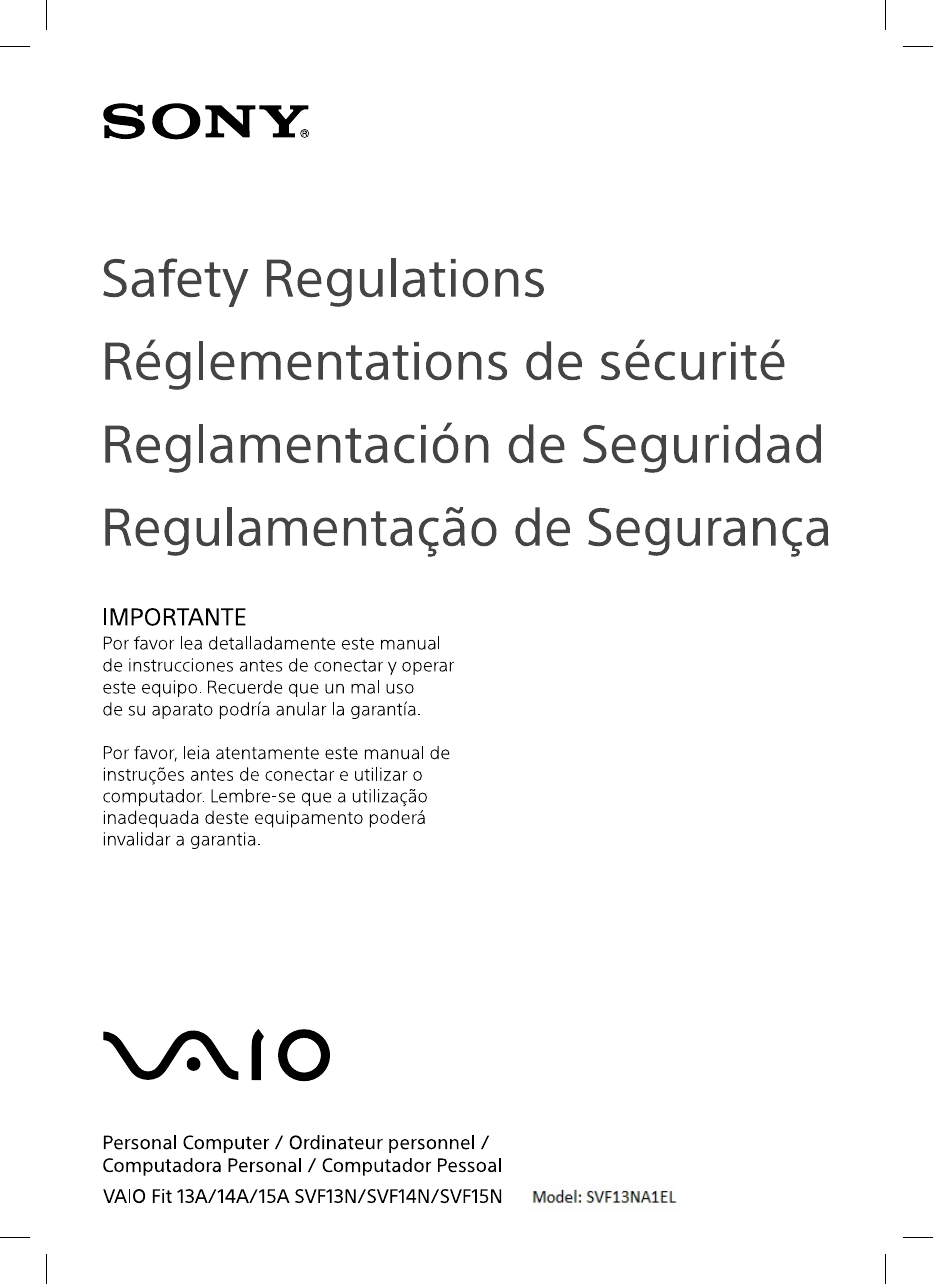
133Q_Safety_7660_7680_7690_US 4-487-018-11 (1)
4-487-018-11(1)

2
133Q_Safety_7660_7680_7690_US 4-487-018-11 (1)
For customers in USA and Canada
Pour les utilisateurs aux Etats-Unis
et au Canada
Owner’s Record
The model number and serial number are located on the bottom, the back panel, or inside the back
panel or the battery compartment of your VAIO® computer. Record the model and serial numbers
in the space provided here, and keep in a secure location. The model and serial numbers will be
required when calling the Sony Service Center.
Model Number:
Serial Number:
Notice
© 2013 Sony Electronics Inc. Reproduction in whole or in part without written permission is
prohibited. All rights reserved. This manual and the software described herein, in whole or in part,
may not be reproduced, translated, or reduced to any machine-readable form without prior written
approval.
SONY ELECTRONICS INC. PROVIDES NO WARRANTY WITH REGARD TO THIS MANUAL, THE
SOFTWARE, OR OTHER INFORMATION CONTAINED HEREIN AND HEREBY EXPRESSLY DISCLAIMS ANY
IMPLIED WARRANTIES OF MERCHANTABILITY OR FITNESS FOR ANY PARTICULAR PURPOSE WITH
REGARD TO THIS MANUAL, THE SOFTWARE, OR SUCH OTHER INFORMATION. IN NO EVENT SHALL
SONY ELECTRONICS INC. BE LIABLE FOR ANY INCIDENTAL, CONSEQUENTIAL, OR SPECIAL DAMAGES,
WHETHER BASED ON TORT, CONTRACT, OR OTHERWISE, ARISING OUT OF OR IN CONNECTION WITH
THIS MANUAL, THE SOFTWARE, OR OTHER INFORMATION CONTAINED HEREIN OR THE USE THEREOF.
SONY CANNOT WARRANT THAT THE FUNCTIONS DESCRIBED IN THIS GUIDE WILL BE
UNINTERRUPTED OR ERROR-FREE. SONY ALSO ASSUMES NO RESPONSIBILITY, AND SHALL NOT BE
LIABLE FOR ANY DAMAGES TO, OR VIRUSES THAT MAY INFECT YOUR COMPUTER EQUIPMENT, OR
OTHER PROPERTY ON ACCOUNT OF YOUR ACCESS TO, USE OF, OR BROWSING IN ANY DESCRIBED
WEB SITE, OR YOUR DOWNLOADING OF ANY MATERIALS, DATA, TEXT, IMAGES, VIDEO, OR AUDIO
FROM ANY DESCRIBED WEB SITE. WEB SITE INFORMATION IS OBTAINED FROM VARIOUS SOURCES
AND MAY BE INACCURATE. COPIES OF COPYRIGHTED INFORMATION MAY ONLY BE MADE FOR
LEGALLY PERMISSIBLE PURPOSES.
Sony Electronics Inc. reserves the right to make any modification to this manual or the information
contained herein at any time without notice. The software described herein is governed by the
terms of a separate user license agreement.
This product contains software owned by Sony and licensed by third parties. Use of such software
is subject to the terms and conditions of license agreements enclosed with this product. Some of
the software may not be transported or used outside the United States. Software specifications are
subject to change without notice and may not necessarily be identical to current retail versions.
Certain product(s) included with this computer may include features such as copy protection and
content management technology. USE OF THE SOFTWARE PRODUCT(S) REQUIRES AGREEMENT TO
APPLICABLE END USER AGREEMENTS AND FULL COMPLIANCE WITH APPLICABLE PRODUCT
ACTIVATION PROCEDURES. Product activation procedures and privacy policies will be detailed
during initial launch of the software product(s), or upon certain reinstallations of the software
product(s), or reconfigurations of the computer, and may be completed by Internet or telephone
(toll charges may apply).
Updates and additions to software may require an additional charge. Subscriptions to online
service providers may require a fee and credit card information. Financial services may require prior
arrangements with participating financial institutions.

3
133Q_Safety_7660_7680_7690_US 4-487-018-11 (1)
Important information for Canadian customers: Your new VAIO® computer includes certain
software versions or upgrades, and Internet services or offers that are available to U.S. customers
only.
Sony, VAIO, and the VAIO logo are trademarks or registered trademarks of Sony Corporation.
All other trademarks are trademarks or registered trademarks of their respective owners.
The Wireless LAN functionality, which is incorporated into selected
models only, has passed Wi-Fi certification and complies with the
interoperability specifications established by WFA (Wi-Fi Alliance).
Reverse engineering or disassembly is prohibited.
End User / Product Activation Requirements
Certain software product(s) included with this computer may include features such as copy
protection and content management technology. Use of the software product(s) requires
agreement to applicable end user agreements and full compliance with applicable product
activation procedures. Product activation procedures and privacy policies will be detailed during
initial launch of the software product(s), or upon certain reinstallations of the software product(s) or
reconfiguration of the computer, and may be completed by Internet or telephone (toll charges may
apply).

4
133Q_Safety_7660_7680_7690_US 4-487-018-11 (1)
Safety Information and Caution
For questions regarding your product or for the Sony Service Center nearest you, visit the Sony
online support web site at http://www.sony.com/am/vaiosupport/.
For the State of California, USA
Perchlorate Material - special handling may apply, See
www.dtsc.ca.gov/hazardouswaste/perchlorate/
Perchlorate Material: Lithium battery contains perchlorate.
To prevent fire or shock hazard, do not expose your computer to rain or moisture.
Do not open the cabinet if it is unnecessary. If you need to open the cabinet, follow the
instructions in the user guide. Do not touch any parts other than those specified in the user
guide. Touching unspecified parts may cause electrical shock.
Turning off your computer with the (power) button does not disconnect the computer
completely from mains voltage. To disconnect it completely, unplug the AC adapter or the
power cable from mains. The socket-outlet shall be installed near the equipment and shall be
easily accessible.
Do not use your computer directly on your lap. The temperature of the base of the unit will
rise during normal operation and over time could result in discomfort or burns.
Do not place the AC adapter in contact with your skin. Remove the AC adapter away from
your body if it becomes warm and causes discomfort.
Do not block the air exhaust or intake vents while the computer is in operation.
Blocking the air vents leads to restriction on air circulation, which can cause internal
overheating, resulting in deformation of the computer, a malfunction, or a fire hazard.
Observe the following precautions to provide adequate air circulation and to ensure normal
reliable operation:
Do not use the computer on any cloth covered surfaces such as rugs, cushion or
blankets, near draperies, or on dusty surfaces that may block its air vents. Always use
the computer on flat surfaces.
Do not use the computer and/or the AC adapter while covered or wrapped in cloth.
Ensure the AC adapter operates in a clear environment.
Before putting your computer in a bag, turn off the computer or place it into Sleep
mode. If the computer is equipped with the power indicator, make sure the power
indicator light is off.
When holding the computer, be sure to wait until it cools down. The surface around the air
exhaust vent may be extremely hot.
To prevent possible damage and risk of ignition to your computer during transportation, first
attach any supplied connector covers and slot protectors in their appropriate locations, and
secure the battery pack in the battery compartment if it is removable.
Do not use or store your computer in a location subject to heat sources, such as radiators or
air ducts; direct sunlight; excessive dust; moisture or rain; mechanical vibration or shock;
strong magnets or speakers that are not magnetically shielded; excessively high and low
temperatures; and high humidity.
Do not charge the battery pack in any way other than as described in the user guide or as
designated by Sony in writing.
Sony recommends using the genuine Sony AC adapter that is provided with this product. If
the item needs to be replaced during the life of the product, be sure to use a compatible
genuine Sony AC adapter. Information about compatible models can be found at
http://www.sony.net/.
Sony disclaims and shall assume no responsibility in case of any losses and damages arising
from:
the use of non-genuine Sony battery packs or AC adapters with your VAIO® computer.
the disassembly, alteration of, or tampering with any Sony battery pack.

5
133Q_Safety_7660_7680_7690_US 4-487-018-11 (1)
Do not use wireless functionality on hospital premises. Doing so may cause medical devices
to malfunction.
Check for and respect airline restrictions on use of wireless capabilities. If use of the wireless
function is prohibited on the airline, disable all wireless connections before boarding.
For Windows 8 models, open the charms by pointing to the top right corner of the screen,
then move the pointer down and select the Settings charm. Select the network icon and then
turn on Airplane mode.
For Windows 7 models, right-click the VAIO Smart Network icon in the desktop notification
area and select the option to disable all wireless connections.
If you urgently need to disable the wireless function, turn off the computer.
For models with a wireless keyboard and/or a wireless mouse, turn off the wireless devices as
well.
If using wireless functionality near a pacemaker, make sure it is at least 8 inches / 20 cm away
from the pacemaker.
Sony is not responsible for any interference that you may experience or that may be caused
when operating this device.
Do not clean your computer with aerosol products (air dusters, aerosol sprays, etc.) that
contain flammable gas. Doing so may fill the inside of the computer with gas and if the
motors, the switch contacts, or other internal parts of the computer spark, the gas may ignite
and it could cause an explosion or fire.
On viewing 3D images (for 3D-capable models only)
Be sure to follow the instructions in the manuals that came with the 3D display you use when
viewing 3D images.
Some people may experience discomfort (such as eye strain, fatigue, or nausea) while
watching 3D video images or playing stereoscopic 3D games. Sony recommends that all
viewers take regular breaks while watching 3D video images or playing stereoscopic 3D
games. The length and frequency of necessary breaks will vary from person to person. You
must decide what works best. If you experience any discomfort, you should stop watching the
3D video images or playing stereoscopic 3D games until the discomfort ends; consult a doctor
if you believe necessary.
You should also see the instruction manual of any other device or software used with this
computer.
The vision of young children (especially those under six years old) is still under development.
Consult your doctor (such as a pediatrician or eye doctor) before allowing young children to
watch 3D video images or play stereoscopic 3D games. Adults should supervise young
children to ensure they follow the recommendations listed above.

6
133Q_Safety_7660_7680_7690_US 4-487-018-11 (1)
Avertissement
Pour toute question concernant ce produit, veuillez ècrire à Sony Customer Information Service
Center au 12451 Gateway Blvd., Fort Myers, FL 33913, USA ou se trouve le Sony Customer Service
(service consommateur de Sony) sur Internet à : http://www.sony.com/am/vaiosupport/.
Pour prévenir tout risque d’incendie ou d’électrocution, garder cet appareil à l’abri de la pluie
et de l’humidité.
N’ouvrez l’armoire qu’en cas de nécessité absolue. Si vous devez impérativement l’ouvrir,
suivez les instructions fournies dans le guide d’utilisation. Ne touchez aucune pièce autre que
celles indiquées dans le guide d’utilisation, sans quoi vous risqueriez de subir une décharge
électrique.
Si vous éteignez votre ordinateur à l’aide du bouton (bouton d’alimentation), vous ne le
débranchez pas complètement de la tension de secteur. Pour le débrancher entièrement,
déconnectez l’adaptateur c.a. ou le câble d’alimentation de la prise. L’appareil doit être le plus
près possible d’une prise murale pour en faciliter l’accès.
Ne posez pas l’ordinateur directement sur vos genoux. Durant le fonctionnement normal, la
température augmente et cela pourrait créer un inconfort ou des brûlures.
Ne mettez pas l’adaptateur c.a. en contact avec votre peau. Éloignez l’adaptateur c.a. de votre
corps s’il devient chaud et qu’il cause un inconfort.
Lorsque l’ordinateur fonctionne, ne bloquez pas la sortie d’air ou des évents d’aération.
Si vous bloquez les évents d’aération, cela pourrait restreindre la circulation d’air et causer
une surchauffe interne pouvant entraîner une déformation de l’ordinateur, une défaillance ou
un risque d’incendie.
Afin d’assurer une circulation d’air normale et un fonctionnement fiable standard, suivez les
précautions suivantes :
N’utilisez pas l’ordinateur sur une surface couverte de tissu, comme un tapis, un coussin
ou une couverture, près d’une draperie ou d’une surface poussiéreuse susceptible de
bloquer les évents d’aération. Utilisez toujours l’ordinateur sur une surface plate.
N’utilisez pas l’ordinateur et/ou l’adaptateur c.a. lorsqu’il est recouvert d’une toile.
Assurez-vous que l’adaptateur c.a. fonctionne dans un environnement dégagé.
Avant de ranger votre ordinateur dans une sacoche, éteignez l’ordinateur ou mettez-le
en mode Veille. Si l’ordinateur est équipé d’un témoin d’alimentation, assurez-vous que
le témoin d’alimentation est éteint.
Lorsque vous tenez l’ordinateur, assurez-vous qu’il est refroidi. Il est possible que la surface
autour d’un évent d’aération soit extrêmement chaude.
Afin de prévenir des indemnités à votre ordinateur pendant le transport, attachez d’abord
tous les volets de connecteurs et protecteurs d’emplacements comme il convient, et insérez
la batterie dans le logement de la batterie si elle est amovible.
N’utilisez pas votre ordinateur et ne le rangez pas dans un endroit exposé à des sources de
chaleur, comme des radiateurs ou des conduits d’air ; le rayonnement solaire. Ne l’exposez
pas non plus à une quantité excessive de poussière ; à l’humidité ou la pluie ; à une vibration
mécanique ou à un choc ; à des aimants puissants ou à des haut-parleurs non protégés
contre les champs magnétiques ; à des températures extrêmement basses ou hautes et à une
humidité intense.
N’essayez pas de charger le module batterie d’une autre façon que celle décrite dans le Guide
de l’utilisateur ou dans la documentation écrite de Sony.
Sony recommande d’utiliser son adaptateur c.a. authentique fourni avec le produit. Si,
pendant sa durée de vie, il s’avère nécessaire de remplacer le produit, assurez-vous d’utiliser
un adaptateur c.a. Sony authentique et compatible. Vous pourrez trouver les renseignements
sur les modèles compatibles à l’adresse suivante : http://www.sony.net/.
Sony rejette toute responsabilité en cas de perte ou de dommages engendrés par l’utilisation
de modules batterie ou d’adaptateurs secteur de marque autre que Sony avec votre
ordinateur VAIO®, ou par le désassemblage ou l’altération des modules batterie Sony.

7
133Q_Safety_7660_7680_7690_US 4-487-018-11 (1)
Ne pas utiliser la fonctionnalité sans fil dans les hôpitaux car cela risquerait de provoquer le
mauvais fonctionnement des appareils médicaux.
Vérifiez et respectez les restrictions des compagnies aériennes concernant l’utilisation des
fonctions sans fil. Si une compagnie interdit l’utilisation d’une fonction sans fil, coupez toutes
les connexions de vos appareils sans fil avant d’embarquer.
Pour les modèles Windows 8, ouvrez les icônes en pointant le coin supérieur droit de l’écran,
puis déplacez le curseur vers le bas et sélectionnez l’icône Paramètres, sélectionnez l’icône
du réseau et activez le Mode Avion.
Pour les modèles Windows 7, faites un clic droit sur l’icône VAIO Smart Network dans la zone
de notification du bureau et sélectionnez l’option pour désactiver toutes les connexions sans
fil.
Si vous avez besoin de désactiver la fonction sans fil de toute urgence, éteignez l’ordinateur.
Pour les modèles équipés d’un clavier et/ou d’une souris sans fil, coupez également les
appareils sans fil.
Si vous utilisez la fonctionnalité sans fil à proximité d’un stimulateur cardiaque, assurez-vous
qu’il est au moins à 8 pouces / 20 cm du stimulateur cardiaque.
Sony n’est pas responsable des interférences que vous risquez de rencontrer ou qui risquent
d’être provoquées lors du fonctionnement de cet appareil.
Ne nettoyez pas votre ordinateur à l’aide de produits en aérosol (bombes d’air sec, sprays
etc.) contenant des gaz inflammables, afin d’éviter toute pénétration de gaz dans l’ordinateur.
En cas d’étincelle provenant des moteurs, des contacts de l’interrupteur ou d’autres pièces
internes de l’ordinateur, le gaz risquerait de prendre feu et de causer une explosion ou un
incendie.
Sur le visionnement d’images 3D (uniquement pour les modèles
compatibles 3D)
Suivez les instructions contenues dans les manuels livrés avec l’affichage 3D que vous utilisez
lorsque vous visualisez des images 3D.
Il est possible que certaines personnes ressentent un inconfort (comme une fatigue de l’oeil
ou des nausées) lorsqu’elles regardent des images vidéo 3D ou lorsqu’elles jouent à des jeux
stéréoscopiques 3D. Sony recommande à tous les spectateurs de prendre régulièrement des
pauses lorsqu’ils regardent des images vidéo 3D ou lorsqu’ils jouent à des jeux
stéréoscopiques 3D. La longueur et la fréquence des pauses nécessaires varient d’une
personne à l’autre. C’est à vous de déterminer ce qui convient le mieux. Si vous éprouvez un
inconfort, vous devez cesser de regarder les images vidéo 3D ou de jouer à des jeux
stéréoscopiques 3D jusqu’à la disparition de l’inconfort ; consultez un médecin si vous le
jugez nécessaire.
Par ailleurs, vous devez consulter le mode d’emploi de tout autre périphérique ou logiciel
utilisé avec cet ordinateur.
La vision des jeunes enfants (particulièrement ceux de moins de six ans) est toujours en
développement. Consultez votre médecin (comme un pédiatre ou un ophtalmologue) avant
de permettre aux jeunes enfants de regarder des images vidéo 3D ou de jouer à des jeux
stéréoscopiques 3D. Les adultes doivent superviser les jeunes enfants afin de s’assurer qu’ils
respectent les recommandations énumérées ci-dessus.

8
133Q_Safety_7660_7680_7690_US 4-487-018-11 (1)
To change the backup battery, please contact your nearest Sony Service
Center.
Pour changer la pile de rechange, veuillez contacter votre centre de service
Sony le plus près.
Wireless LAN Security
Creating security settings for a Wireless LAN is extremely important. Sony assumes no responsibility
for any security problems that may arise from the use of a Wireless LAN.
Sécurité du réseau local sans fil
La création de paramètres de sécurité pour le réseau local sans fil est extrêmement importante.
Sony n’est pas tenu responsable des problèmes de sécurité susceptibles de se produire lors de
l’utilisation du réseau local sans fil.
The following cautions apply to the models which support the
IEEE 802.11a/n (5 GHz) .
Only use Wireless LAN indoors when using it with IEEE 802.11a/n (5 GHz) .
High power radars are allocated as primary users (meaning they have priority) of 5250-5350 MHz
and 5650-5850 MHz and these radars could cause interference and/or damage to this device.
This device uses the 5 GHz band for wireless LAN communication and the maximum gain of the
antenna in this device is 1.07 dBi.
Les avis suivants se rapportent aux modèles qui prennent en charge la norme
IEEE 802.11a/n (5 GHz) .
Utiliser le réseau local sans fil à l’intérieur uniquement lorsqu’il est utilisé avec
IEEE 802.11a/n (5 GHz) .
Les radars à haute puissance sont alloués en tant qu’usagers principaux (ce qui signifie qu’ils
ont la priorité) de 5 250-5 350 MHz et 5 650-5 850 MHz et ces radars pourraient provoquer des
interférences ou encore des dommages à l’appareil.
Ce périphérique utilise une bande de fréquences 5 GHz lors de communication sans fil LAN et le
gain maximal de l’antenne de l’appareil est de 1.07 dBi.

9
133Q_Safety_7660_7680_7690_US 4-487-018-11 (1)
The following FCC statements apply only to the version of this model manufactured for sale in the
USA. Other versions may not comply with FCC technical regulations, and the FCC statements are not
applicable in Canada, including the Province of QUEBEC.
L’avis suivant de la FCC s’applique uniquement à la version de ce modèle fabriqué pour être vendu
aux É.-U. Il est possible que d’autres versions ne soient pas conformes aux règlements techniques
de la FCC. Par ailleurs, l’avis de la FCC ne s’applique pas au Canada, y compris dans la province de
QUÉBEC.
FCC Information (USA)
This equipment has been tested and found to comply with the limits for a Class B digital device,
pursuant to Part 15 of the FCC Rules. These limits are designed to provide reasonable protection
against harmful interference in a residential installation. This equipment generates, uses, and can
radiate radio frequency energy and, if not installed and used in accordance with the instructions,
may cause harmful interference to radio communications. However, there is no guarantee that
interference will not occur in a particular installation. If this equipment does cause harmful
interference to radio or television reception, which can be determined by turning the equipment off
and on, the user is encouraged to try to correct the interference by one or more of the following
measures:
Reorient or relocate the receiving antenna.
Increase the separation between the equipment and receiver.
Connect the equipment into an outlet on a circuit different from that to which the receiver is
connected.
Consult the dealer or an experienced radio/TV technician for help.
Changes or modifications not expressly approved by the party responsible for compliance could
void the user’s authority to operate the equipment.
NOTE: The manufacturer is not responsible for any radio or TV interference caused by unauthorized
modifications to this equipment. Such modifications could void the user’s authority to operate the
equipment.
Only peripherals (computer input/output devices, terminals, printers, etc.) that comply with FCC
Class B limits may be attached to this computer product. Operation with noncompliant peripherals
is likely to result in interference to radio and television reception.
All cables used to connect peripherals must be shielded and grounded. Operation with cables
connected to peripherals that are not shielded and grounded may result in interference to radio
and television reception.

10
133Q_Safety_7660_7680_7690_US 4-487-018-11 (1)
FCC/IC Radio Frequency Exposure
The available scientific evidence does not show that any health problems are associated with using
low power wireless devices. There is no proof, however, that these low power wireless devices are
absolutely safe. Low power Wireless devices emit low levels of radio frequency energy (RF) in the
microwave range while being used. Whereas high levels of RF can produce health effects (by
heating tissue), exposure to low level RF that does not produce heating effects causes no known
adverse health effects. Many studies of low level RF exposures have not found any biological
effects. Some studies have suggested that some biological effects might occur, but such findings
have not been confirmed by additional research.
This equipment has been tested and found to comply with FCC/IC radiation exposure limits set
forth for an uncontrolled environment and meets the FCC radio frequency (RF) Exposure Guidelines
in Supplement C to OET65 and RSS-102 of the IC radio frequency (RF) Exposure rules.
Exposition aux radiofréquences FCC/IC
Selon les preuves scientifiques disponibles, aucun problème de santé n’est associé à l’utilisation
d’appareils sans fil de faible puissance. Rien ne prouve cependant que ces appareils sont
absolument sans danger. Lorsqu’ils sont utilisés, les appareils sans fil de faible puissance émettent
de faibles niveaux d’énergie radiofréquence (RF) dans la gamme des hyperfréquences. Bien que les
niveaux élevés de radiofréquence puissent avoir un effet sur la santé (réchauffement des tissus),
l’exposition à de faibles niveaux n’ayant pas d’effet thermique n’a aucun impact négatif connu sur
la santé. De nombreuses études sur l’exposition aux radiofréquences de faible niveau n’ont révélé
aucun effet biologique. Certaines d’entre elles ont sous-entendu qu’il pourrait y avoir de tels effets,
mais leurs résultats n’ont pas été confirmés par des recherches supplémentaires.
Cet equipement a ete teste et s’est avere conforme aux limites d’exposition aux rayonnements
definies par la FCC et IC pour l’environnement non controle ; il repond aux regles sur l’exposition
aux rayonnements RF (radiofrequence) figurant dans le Supplement C de la norme OET65 de la FCC
et a celles de la norme RSS-102 d’IC.
IC RSS (Canada)
For the 5GHz band only
To prevent radio interference to the licensed service, this device is intended to be operated indoors
and away from windows to provide maximum shielding. Equipment (or its transmit antenna) that is
installed outdoors is subject to licensing.
Pour la bande 5GHz seulement
Pour empêcher que cet appareil cause du brouillage au service faisant l’objet d’une licence, il doit
être utilisé à l’intérieur et devrait être placé loin des fenêtres afin de fournir un écran de blindage
maximal. Si le matériel (ou son antenne d’émission) est installé à l’extérieur, il doit faire l’objet
d’une licence.
This device complies with Industry Canada license-exempt RSS standard(s).
Operation is subject to the following two conditions: (1) this device may not cause harmful
interference, and (2) this device must accept any interference received, including interference that
may cause undesired operation of the device.
Le présent appareil est conforme aux CNR d’Industrie Canada applicables aux appareils radio
exempts de licence.
L’utilisation de ce dispositif est autorisée seulement aux deux conditions suivantes : (1) il ne doit
pas produire de brouillage, et (2) l’utilisateur du dispositif doit être prêt à accepter tout brouillage
radioélectrique reçu, même si ce brouillage est susceptible de compromettre le fonctionnement du
dispositif.

12
133Q_Safety_7660_7680_7690_US 4-487-018-11 (1)
Specifications of the supplied battery pack
Model number : VGP-BPS41
Maximum Charge Current : 2.957 A
Maximum Charge Voltage : 12.96 V

12
133Q_Safety_7660_7680_7690_US 4-487-018-11 (1)
For customers in USA
Regulatory Information
If you have questions about this product, you can write to the Sony Customer Information Service
Center at 12451 Gateway Blvd., Fort Myers, FL 33913, USA or find Sony Customer Service on the Web
site at:
http://www.sony.com/am/vaiosupport/.
Declaration of Conformity
Trade Name: SONY
Model No.: SVF13NA1EL
Responsible Party: Sony Electronics Inc.
Address: 16530 Via Esprillo, San Diego, CA 92127, U.S.A.
Telephone No.:
(For FCC-related matters only) 858-942-2230
This device complies with Part 15 of the FCC Rules. Operation is subject to the following two
conditions:
(1) this device may not cause harmful interference, and
(2) this device must accept any interference received, including interference that may cause
undesired operation.

133Q_Safety_7660_7680_7690_US 4-487-018-11 (1)
Printed in China © 2013 Sony Corporation